#gemma gracewood
Text






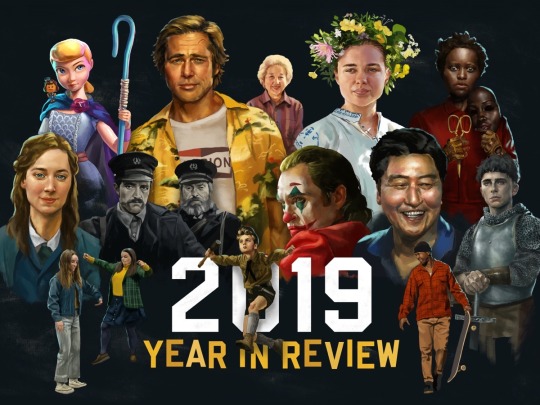

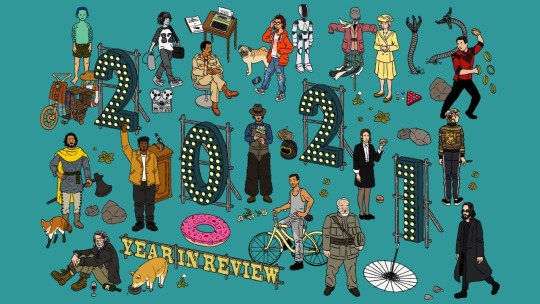

The Letterboxd Year in Review, 2013-2022
12 2013 2014 2015 2016 2017 2018 2019 2020 2021 2022
#it started in 2012 but there wasn’t a header that year#ilya milstein#joseph qiu#eleni kalorkoti#letterboxd#letterboxd year in review#movies#film#matthew buchanan#gemma gracewood#Louise Zergaeng Pomeroy#2022 letterboxd year in review
2 notes
·
View notes
Photo

Poker Face.
Tiffany Haddish tells Gemma Gracewood about taking a holiday from comedy in Paul Schrader’s The Card Counter, her hotel comfort viewing, and why Oscar Isaac thinks of her as Jesus.
“When I say yes to a movie, that’s a hundred to two hundred people that get to work and I want them to be happy about working.” —Tiffany Haddish
Comedians taking on dramatic roles is not an innovation in cinema, but it’s which comedian, in which role, that makes a casting choice a talking point. Melissa McCarthy in Can You Ever Forgive Me? Mo’Nique in Precious. Peter Sellers in Being There. Robin Williams in everything.
In The Card Counter, Paul Schrader’s meditative slow-burn on American shame, part of the tension as a viewer lies in what we already appreciate about Tiffany Haddish as a performer. She is an unbridled crack-up, a live wire on screen and off, a former foster kid committed to busting unsustainable Hollywood beauty myths by wearing the same dress throughout an awards season. Her physical comedy is electric, even when it’s a simple raise of an eyebrow.
The wildest thing about La Linda—a gamblers’ agent working the mid-level casino circuit, who spies, in Oscar Isaac’s William (Bill) Tell, a potential new thoroughbred for her stable of card counters—is the way her drinks order changes from hotel bar to hotel bar. “I came in there with my comedy ways and it sucked,” Haddish laughs, disarmingly honest about her leap from the hi-jinks her fans know her for, to her dramatic role in Schrader's new film. “Paul was hard on me at first,” she recalls. “He had to reel me in, make adjustments, strip all this stuff off, all my tools, leave me with these instruments I barely ever use.”
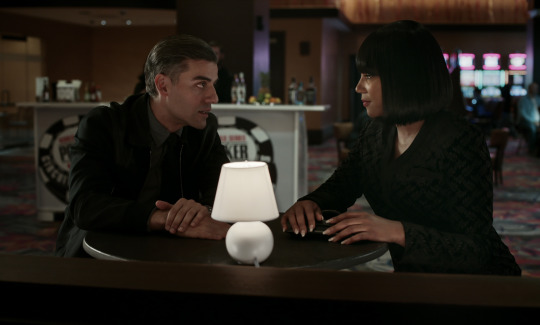
Oscar Isaac and Tiffany Haddish in a scene from ‘The Card Counter’.
There’s an enduring myth that drama is tougher to pull off than comedy, something Haddish’s friend Morris Chestnut corrected her on a few years back. “He’s like, ‘No, what you do, that’s hard work. You are actually overworking yourself, doing these comedies.’ And I’m like, ‘He don’t know what he’s talking about.’ Then I actually did a drama. And I was like, ‘Oh, that was so easy. Oh, that was beautiful.’ It’s way easier. It’s way easier.”
What La Linda doesn’t know, but any casual observer of Schrader’s work will, is that Isaac’s Bill has a past, and that his methodical attempts to keep his guilt in check through a supremely minimal lifestyle, perhaps even to allow himself a spark of pleasure—redemption, even—are about to come unwound.
Before that, though, there’s time for La Linda, Bill and Cirk (Tye Sheridan)—the son of one of Bill’s former, shall we say, colleagues—to become an odd little chosen-family unit as they travel the circuit. Bill and La Linda cook up a nice heat while killing time in cocktail lounges, and her casual business charisma is a charming offset to the deeper themes at play. Writing fresh from a Venice Film Festival viewing, Rahul notes “you keep expecting Haddish to break out of the understated style and that tension works.” Andy agrees: “Her simple outlook on life and lack of existentialism offer a nice contrast to Tell’s brooding sorrow. Plus, La Linda is just a great character name.”

Haddish understood the pull between Bill and La Linda, and La Linda’s desire to probe into his mysterious monotony, in a very specific way: “As a standup comedian, I work with a lot of men that—they’re very talented, they’re doing big things when they’re on stage—but then when they come off the stage you’re like, ‘Who are you? Why are you so dark? Who hurt you? What’s going on?’ I can relate to that in so many ways.”
Still, of all the dramatic writer-directors to work with in America, why Schrader? What was it about his specific brand of lonely-white-man stories that appealed? “Cat People. It’s my jam,” declares Haddish, of Schrader’s 1982 erotic horror reimagining of the 1942 classic (and one of his few films with a female lead, played by Natassja Kinski). “I love that movie. It had some weird, twisted shit in it.” She has been campaigning Schrader to mount a sequel, so that she can have a crack at playing a sexy, predatory jungle cat. “I try to bring it up to him all the time. And he’s like, ‘Tiffany, we’re not doing it. No.’”

Natassja Kinski in Paul Schrader’s 1982 remake of ‘Cat People’.
Haddish imagines that Cat People would certainly be on La Linda’s list of hotel-room comfort watches, along with Shaft and Goodfellas. Haddish, on the other hand, prefers to kick back with series television when she is on the road. “I watch old sitcoms like Martin or, like, The Facts of Life. I love a good cartoon, especially the throwback ones on Boomerang. I really like the old school, like ThunderCats. That’s a good wind down for me.”
Filming days are long, making the minutes can be stressful, and Covid safety protocols add layers of complexity to the job. There are performers who are cast not only for what they bring to their roles, but also for the energy they bring to set. Haddish has an undeniable magnetism, so it is unsurprising to read her co-star Isaac, in The Card Counter’s production notes, describe her as being “like Jesus”, in that people would drop everything and follow her. She enjoys this comparison, revealing that she has always wanted to be an AD, the crew member with, traditionally, the greatest people skills. “I always wanted to be assistant director just so I can be like, ‘All right, picture’s up, guys.’ And just so I can know everybody and be cool with everybody.”
But as a performer with clout, what is her intention when she—Tiffany Haddish, famous actress™—walks onto a soundstage? Haddish’s answer is a generous primer on how to be a good sort on set (or, indeed, in any working environment). “When I say yes to a movie, that’s a hundred to two hundred people that get to work and I want them to be happy about working,” she explains. “I’m going to work with them again in something else, and I want to have a pleasant experience with the crew. The DP, the gaffers, all these people, we all work together as a unit, so I think it’s super important.”
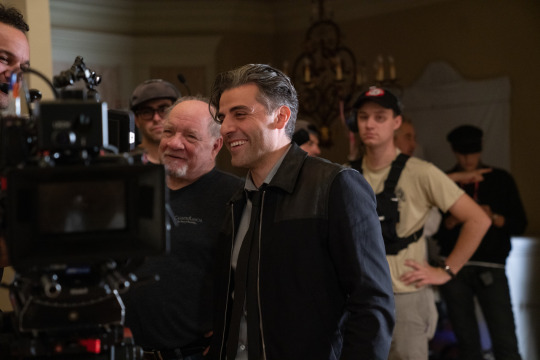
Paul Schrader, Oscar Isaac and crew on the set of ‘The Card Counter’.
Certain crew members, she admits, “are imperative to making me look good”, but more than that, her approach is grounded in her own physical and emotional safety in an often volatile and unpredictable creative environment. “I see how some actors won’t talk to any crew members at all, and I feel like that’s not okay because these people are busting their ass to make you look great, and they are part of telling this story too. They might not be hanging off the side of the building like you are, but they are making sure that the camera’s operating correctly, so you don’t have to shoot it five hundred times.
“These people keep me alive. They keep me going and they can tell when I’m in a bad space. They’re like, ‘Here’s a Snickers.’ If I’m working with an actor who might be treating me not the best, they’re coming over, they’re giving encouraging words, ‘You’re going to be okay.’ We’re a team. I even talk to the editor. They’re like, ‘Picture’s up, sound’s rolling, and speed.’ And I’d be like [staring down the camera lens], ‘What’s up editor? Hey, it’s your girl Tiffany Haddish. Just a little note: I’m thinking about you. Now, if you could just make sure this lazy eye is this way… I know you’re in that room by yourself, but look out for your girl.” Sometimes, Haddish will even throw a bone to the studio executives. “I know they’re watching the dailies,” she laughs.
Her investment in the welfare of her film families is paying off in unexpected turns such as The Card Counter, with more to come. Up next, a trio of unusual comedies: Jerrod Carmichael’s existential buddy farce On the Count of Three, which was picked up by Annapurna out of Sundance this year; Cory Finley’s surrealistic sci-fi romp Landscape with Invisible Hand; and the intriguing Nicolas Cage vehicle, The Unbearable Weight of Massive Talent.
Related content
A list of favorite gambling movies from Gamblers, a podcast from The Big Picture’s Sean and Amanda
Life Detained: Jack Moulton’s interview with Kevin Macdonald, director of The Mauritanian
Josh’s list of Neo-Noir films
Follow Gemma on Letterboxd
‘The Card Counter’ is in US cinemas now.
#the card counter#paul schrader#tiffany haddish#cat people#oscar isaac#tye sheridan#gambling movies#neo noir#girls trip#actress#Black actress#letterboxd#gemma gracewood#morris chestnut#filmmaking tips#goodfellas
11 notes
·
View notes
Text
ngl every time i see a new one of those commissioned letterboxd pride month editorial pieces get published it does sting just a little bit. idk how real writers/journalists do it on a regular basis and for a living
#maybe the wider letterboxd audience just wasnt ready for the singer not the song.#maybe the nonseriousness of my letterboxd profile was a turn off#maybe gemma gracewood hates vietnamese people and me specifically.#i guess well never know </3
11 notes
·
View notes
Text
Entenda como a rede social Letterboxd se transformou em blockbuster na pandemia

No começo da década passada, Matthew Buchanan e Karl von Randow, web designers radicados em Auckland, na Nova Zelândia, estavam em busca de um projeto paralelo.
A empresa deles, um estúdio de web design chamado Cactuslab, desenvolvia sites e apps para diversos clientes, mas eles queriam um projeto que os interessasse pessoalmente, no qual sua equipe pudesse trabalhar quando não estivesse ocupada com outras tarefas.
Buchanan pensou num site de mídia social sobre filmes. Na época, ele usava o Flickr para compartilhar fotos e o Last.fm para compartilhar suas preferências musicais. O IMDb era um banco de dados; não era social em essência. Isso deixava uma lacuna naquele campo. O resultado foi um app e rede de mídia social chamado Letterboxd, que se descreve, corretamente, em seu site como “o Goodreads dos filmes”.
Depois de ser apresentado na conferência online Brooklyn Beta, há dez anos, o Letterboxd logo começou a atrair um grupo modesto mas apaixonado de fãs de cinema, ávidos por registrar seus hábitos de consumo cinematográfico, criar listas de favoritos e escrever e postar resenhas.
No ano passado, porém, o site registrou crescimento explosivo. O Letterboxd viu sua base de usuários praticamente dobrar desde que surgiu a pandemia. Agora o serviço tem mais de 3 milhões de contas, de acordo com a companhia, ante 1,7 milhão neste momento do ano passado.
E não foi só o número de usuários que cresceu, mas o uso. “A atividade por membro cresceu”, disse Buchanan, numa recente entrevista por Zoom. “Todos os nossos indicadores apontam alta.”
A receita do site também cresceu, com publicidade e assinaturas pagas opcionais que dão recursos adicionais aos usuários. A empresa deixou de ser um projeto paralelo de Buchanan e Von Randow, e nos últimos 12 meses eles contrataram diversos empregados de período integral para o projeto.
A pandemia foi desastrosa para a indústria cinematográfica, já que as salas de cinema em geral permaneceram fechadas e filmes de arrecadação potencialmente enorme, como “Tenet”, apresentaram desempenho drasticamente inferior ao previsto.
Mas, para o Letterboxd, todo o tempo adicional que as pessoas passaram em casa foi uma imensa vantagem. “Amamos conversar sobre cinema”, disse Gemma Gracewood, a editora-chefe do Letterboxd. “E estamos conversando muito mais sobre aquilo que amamos, recentemente, porque estamos todos trancados em casa.”
No começo, o Letterboxd atraía principalmente os obcecados por filmes –cinéfilos extremos, devotos das estatísticas e críticos profissionais em busca de um lugar em que publicar todos os seus trabalhos sob o mesmo teto.
Mike D’Angelo, veterano colaborador das revistas Entertainment Weekly e Esquire, usou o Letterboxd a fim de registrar retroativamente, por data, todos os filmes a que já assistiu, desde janeiro de 1992. Além de subir resenhas antigas para a plataforma, ele usa o site como uma espécie de diário para considerações ocasionais.
“Se estou escrevendo uma resenha profissional, meu público é a audiência geral”, ele disse em conversa por telefone. “Já no Letterboxd, não me preocupo com informações obrigatórias no jornalismo, como um resumo da trama. Faço piadas e referências que, para entender, um leitor precisaria de conhecimento bastante aprofundado sobre cinema. É uma forma de escrever muito mais libertadora.”
Essa liberdade confere aos textos do Letterboxd um jeitinho de oeste selvagem. O que chega ao topo da página do site dedicada às resenhas mais populares varia radicalmente. Há memes obscuros, ensaios muito pessoais e tratados abrangentes repletos de jargão pseudoacadêmico.
O leitor encontra avaliações altamente politizadas escritas com zelo feroz. “Como ação mais destrutiva no planeta, como fonte de mais guerras, mortes e exploração do que qualquer coisa conhecida desde que surgiu a escravatura, o imperialismo é o aspecto mais alto, mais vil e mais horripilante do capitalismo, e nós nos opomos a ele.” (Isso, é claro, numa resenha de “Mulher-Maravilha”.)
Ou você pode encontrar resenhas de uma só frase, sucintas e crípticas. “Aconteceu isso com meu amigo Eric”, diz uma crítica do filme “Coringa”.
O espírito indisciplinado e de aceitação geral do Letterboxd pode incomodar. D’Angelo admite que fica “enfurecido” quando autores escrevem o texto todo em minúsculas ou se recusam a usar “gramática e pontuação normais”, o que acontece com frequência no site.
Mas a falta de regras ou estruturas também pode resultar em críticas interessantes e nada convencionas, e o site oferece uma plataforma a vozes que de outra maneira não seriam ouvidas. No Letterboxd, é possível descobrir não só novos filmes a assistir como novos críticos.
Sydney Wegner, mãe solteira na região rural do estado americano do Texas, começou a usar o Letterboxd no final de 2012. Sob o nome de usuário @campbart, ela escreve resenhas vívidas e longas (e quase que exclusivamente em minúsculas) sobre filmes de ficção científica, terror e ação, entre as quais um artigo muito emotivo sobre “Minions” que pode ser lido como uma ode poética à sua filha.
“Escrevi daquele jeito porque é o que gosto de ler”, ela disse. “Críticas sempre me parecem meio tediosas a não ser que tenham um aspecto pessoal.”
Wegner disse que jamais tinha pretendido “escrever profissionalmente”, mas, à medida que sua conta começou a ganhar seguidores, ela passou a receber ofertas de trabalho pago como resenhista. Wegner foi entrevistada em podcasts, apresentou sessões de cinema e recebeu pedidos de resenhas dos editores de diversos sites de cinema, entre os quais o Film Freak Central.
Lucy May começou no Letterboxd em 2015 e hoje é uma das usuárias mais populares, com quase 60 mil seguidores. May, de 26 anos, vive com a família no estado americano de Illinois e trabalha num cinema; nas horas vagas, ela assiste a filmes e escreve sobre eles longamente no Letterboxd.
Ainda que May afirme ser “acima e além de tudo uma fã do cinema”, e não uma crítica profissional, ela mesmo assim passou a se considerar crítica. “Eu me definiria como uma crítica da era do Letterboxd”, disse.
May considera que “a onda moderna de críticos” no Letterboxd seja interessante porque “muitas das velhas regras estão sendo jogadas no lixo”.
“Agora há menos reclamações quando pessoas dão más classificações a filmes elogiados do passado e mais amor por coisas como comédias românticas”, ela disse. “A honestidade no Letterboxd me fascina. Não aprendi a escrever na universidade ou qualquer coisa do tipo, mas mesmo assim me considero crítica, nesse novo sentido.”
A explosão de crescimento do Letterboxd de fato favorece os usuários mais jovens. No app, a forma pela qual 75% dos usuários acessam o serviço hoje, de acordo com a companhia, a faixa etária mais presente é a dos 18 aos 24 anos. “O número de membros jovens cresceu demais”, disse Gracewood, a editora-chefe.
E ela afirma que, quando a plataforma atrai esses usuários mais jovens, eles logo percebem uma evolução em seu gosto. “Eles chegam tendo visto ‘A Princesa e a Plebeia: Nova Aventura’ e logo estão vendo ‘Os Guarda-Chuvas do Amor’”, disse.
Essa virada na direção de usuários mais jovens significa que o Letterboxd enfim começa a se expandir fora do grupo fechado dos devotos do cinema —e os mais de 1,2 milhão de novos usuários de 2020 representam muita gente que “não é tecnicamente cinéfila”, explicou Buchanan.
O crescimento propiciou um novo nível de sucesso para a plataforma, e Buchanan vê potencial ainda maior. “Há dezenas de milhões de usuários da Netflix, por exemplo. Sabemos que não vamos atrair todos os usuários da Netflix, mas também sabemos que o apetite por conteúdo relacionado a filmes está crescendo.”
A alta no crescimento indica que, embora a indústria cinematográfica tenha, de muitas maneiras, sido devastada pelos lockdowns e pelo flagelo da pandemia, a cultura do cinema em si continua a prosperar. Talvez não possamos ir ao cinema, mas, como demonstra o sucesso do Letterboxd, ainda queremos falar de filmes.
The post Entenda como a rede social Letterboxd se transformou em blockbuster na pandemia first appeared on Publicidade SP.
from WordPress https://ift.tt/2NWNlAF
via IFTTT
0 notes
Photo
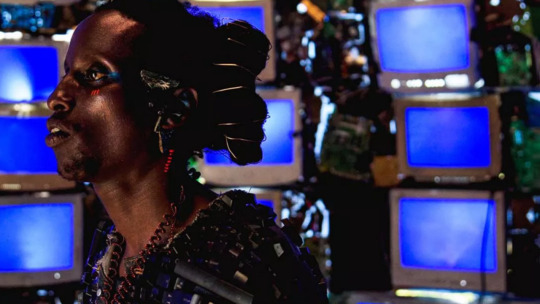
The Eyes of TIFF.
Programmers for the 46th Toronto International Film Festival chat about the degrees of intensity they look for in a festival film, and help us zoom in on the gems from TIFF’s 2021 program, by genre and region.
“Intensity can be achieved in so many different ways. I know it when I feel it. You feel it in your gut.” —Cameron Bailey
It’s almost business as usual for TIFF this year. In-person events and red carpets return, but a healthy virtual program is also available for Canadian-based folk unable to travel, as the Covid-19 pandemic continues its onslaught.
TIFF co-head and artistic director Cameron Bailey has been with the festival for just over half its life, and says while some of the technology has changed in that time—“you’re no longer sitting in front of a TV monitor with VHS tapes… or waiting for 35mm prints to be spooled up and projected for you”—the “basic process of falling in love with movies” has not.
It’s a challenge, Bailey says, to winnow down the films he falls in love with for the final TIFF lineup. And even then, it is an annual challenge for film lovers tight on time to narrow down their own selections. So, ahead of the fest, Bailey joined fellow TIFF programmers for a Twitter Spaces conversation with our editor in chief Gemma Gracewood, in order to help Letterboxd members make some watchlist decisions.
Joining Bailey were Thom Powers (TIFF Docs), Peter Kuplowsky (Midnight Madness), Robyn Citizen (senior programming manager), Diana Sanchez (Special Presentations, Spain, Latin America, Portugal and the Caribbean), Diana Cadavid (International Cinema) and Nataleah Hunter-Young (Africa, “the Middle East” and the Black Diaspora).
Edited highlights of the conversation follow, so have your watchlists close at hand.

‘The Eyes of Tammy Faye’, written by Abe Sylvia and directed by Michael Showalter.
Thank you all for joining me today. You watch a lot of films as you’re going through the selection process. How does one make itself stand out to you?
Cameron Bailey: For every programmer it’s going to be something different. For me, it comes down to an intangible quality of intensity. That can be emotional intensity, it can be the intensity of formal elements, the cinematography, the performances, the writing. Some sense of concentrated emotion and momentum, where you get the sense that a filmmaker is trying to find a way to distill the essence of what they’re trying to do and communicate it to an audience through all of the tools that cinema provides. That doesn’t mean the movie has to be fast-paced or have a lot of dramatic jolts, as intensity can be achieved in so many different ways. I know it when I feel it. You feel it in your gut.
What would you say are some of the performances that have struck you the most this year?
CB: Jessica Chastain is the lead in a film we’re premiering called The Eyes of Tammy Faye, directed by Michael Showalter. If you were watching TV in the ’80s and ’90s, you will remember Tammy Faye Bakker, and her husband, Jim Bakker, who were TV televangelists. You couldn’t miss Tammy, as she had these giant eyes and makeup with giant eyelashes, and this is essentially her story. It’s hard to know at first that it’s Jessica Chastain underneath all of that makeup, but she gives a performance that’s not just about the exterior. It’s about a woman who is shaped by a difficult upbringing, shaped by this incredibly deep need she has for affirmation, to be on TV, to be in front of the camera, and that guides her decisions into extremes. She’s fantastic in it.
Benedict Cumberbatch is back with two films. He is the lead in Jane Campion’s The Power of the Dog. It’s an understated, slow-burn performance in some ways, which he can do so well. He’s also in a film that’s on the opposite end of the dramatic spectrum, The Electrical Life of Louis Wain. It’s based on a real person, and when you watch the film you will be amazed that this person actually existed. Wain, in the early part of the twentieth century, was a prodigious painter who turned his talent towards painting thousands of cats. Cute cats, big eyed cats, fuzzy, adorable cats. He’s largely responsible for cats becoming as big as they are as domesticated pets. It’s a wild story.
I’m still recovering from watching The Power of the Dog’s trailer earlier today, and had to promise myself that I wouldn’t take up this entire time talking about Jane Campion’s obsession with hands. The Spencer trailer dropped as well, which has a lot of buzz around it.
CB: Yes, Spencer is a remarkable portrait. Some of us remember Princess Diana, some of us have watched The Crown, and so have a very recent image, but this is a completely different performance that Kristen Stewart gives. She’s remarkable in it. I think everybody’s going to want to see this film.

‘Charlotte’, written by David Bezmozgis and Erik Rutherford, directed by Tahir Rana and Éric Warin.
Are there any other titles you’d like to get the buzz started for, Cameron?
CB: On the animation side, I would say people should look out for a film called Charlotte, by Tahir Rana and Éric Warin. It’s a Canadian film telling a story based in World War II Europe about a woman in a Jewish family [exiled] in France during the occupation of France by the Nazis. She can feel what is coming. She decides to paint everything about her life, and her family’s life, trying to document what she feels is going to be very fragile, and what she might lose altogether.
As it turns out, before the end of the war she was taken away to a death camp by the Nazi regime, and she didn’t survive, but her paintings have survived and they were turned into a book, along with the story of her family. The animation is just gorgeous. I think that’s one that awards bodies are going to be paying attention to. It’s one of the best animated films I’ve seen in quite a while.
Thom, what are some of the documentary titles that you and the team think those awards bodies will have their eyes on?
Thom Powers: A big one to pay attention to is The Rescue, by Chai Vasarhelyi and Jimmy Chin, who won the Oscar for their last film, Free Solo. Their new film is looking at the Thai cave rescue [in 2018], when a group of young soccer players and their coach got trapped by monsoon floods in a cave. When we were watching the news, we were seeing the journalists reporting from outside the cave. What this film does is bring you inside that rescue using footage that’s never been seen before. Chai Vasarhelyi and Jimmy Chin are masters at the documentary adventure genre, and also [at] bringing a real human side to the people involved, which they do again here.
I’ll also mention Becoming Cousteau, by Liz Garbus, and Julia, a film about Julia Child, directed by Julie Cohen and Betsy West, who made the Oscar-nominated documentary RBG a few years ago. So many of us during the pandemic had to rediscover ourselves in the kitchen, and Julia Child’s life was about making people feel more comfortable in the kitchen, which makes it a terrific film to watch at this time.
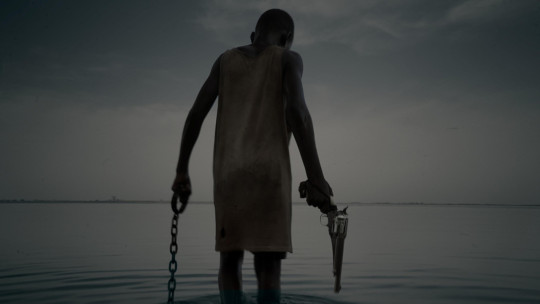
‘Saloum’, directed by Jean Luc Herbulot.
Peter, what’s a movie from this year’s Midnight Madness lineup you’d love to recommend?
Peter Kuplowsky: We’ve got a lot of firsts at Midnight this year. We have Saloum, the first time a West African film has ever been in Midnight. We’ve also got Zalava, which is the first Iranian film to play in Midnight. Our opening film for Midnight Madness is Julia Ducournau’s Titane, which is playing at the Princess of Wales theater, and will be a spectacle to behold. When I’m looking for Midnight Madness, I like hearing the audience make certain noises in the room, whether that’s a gasp or screams or laughter. I feel that every note on the scale is going to be played during Titane by the audience.
Brilliant. Now, we’re going to bring in some audience questions. First up is Vincent, who says that one of their favorite films is Georges Franju’s Eyes Without a Face, and asks if there are any films in this year’s TIFF lineup you could recommend for a fan of that film?
PK: I’ve really been encouraging people to check out the films I just mentioned, Zalava and Saloum, and I think Zalava especially would fit here, as it’s more of a horror-drama. It begins as something that is steeped in the supernatural, but as it escalates it becomes something of a pitch-black comedy while still maintaining a gravitas to it. I think it’s one of the most fascinating discoveries in the genre space this year.
CB: I’d also add Good Madam, by Jenna Bass, from South Africa. It is a chilling movie, with a bit of an Eyes Without a Face vibe. If you like that sort of approach to cinema, I think you’ll like that.
PK: Vengeance Is Mine, All Others Pay Cash just won the Golden Leopard at Locarno. With a title like that, this is a film that feels like it’s going to be sort of a strictly pulp crime film, but it’s so much more. It’s deeply romantic, incredibly eclectic, and beautifully shot on 16mm film. It feels like a film that was hidden away, shot in the late ’70s or early ’80s. It’s a throwback to 1980s Hong Kong action films, while also, I can’t stress this enough, being one of the most romantic films in the festival. You’ll fall in love with this relationship while it’s also working in fight sequences and magical realism.
Nataleah, what’s something you would recommend from your TIFF selections from Africa, “the Middle East” and the Black Diaspora?
Nataleah Hunter-Young: One I’d highly recommend is Costa Brava, directed by Mounia Akl, from Lebanon. Even amidst what’s going on in Lebanon right now, the film offers a beautiful and engrossing portrait of a family that includes a grandmother who’s a non-actor, but has impeccable comedic timing (that travels through the subtitles if you don’t speak Arabic).

‘Snakehead’, written and directed by Evan Leong.
Robyn, what’s a movie that surprised you most during your selections this year?
Robyn Citizen: I always recommend that people check out our Discovery section because that’s where we find new talent and nurture new voices. The film that really surprised me this year was Snakehead, by Evan Jackson Leong. Some people will know him from a documentary called Linsanity, and he did another documentary about evangelism in Korea. Snakehead has been a ten-year labor of love for him. He had to do a Kickstarter for the film, which is loosely based on the life of a woman named Sister Ping, who had a human trafficking ring that was the biggest trafficking ring for about 20 years.
The film tackles what’s going on now with vulnerable populations being trafficked into America, in particular Chinatown in the US, and the main character, played by Shuya Chang, has to fight to find her daughter. It’s an exciting film, and very moving. It’s extremely tightly edited, and it looks fantastic.
We’ve got our next question here from a member who says their favorite genre is science-fiction. While Dune is at the top of their watchlist, are there any other sci-fi selections you could recommend?
PK: I would recommend After Blue (Dirty Paradise), which is a perverse science-fiction by Bertrand Mandico. It reminds me a lot of the French animated film Fantastic Planet. This one is about a planet which is inhospitable to men because of the way hair grows. The plot follows a young teenage girl who accidentally unleashes a notorious criminal that she and her hairdresser mother have to stalk through the alien landscape that is full of bizarre creatures and liquids and gases. I feel it’s kind of like the inverse of Dune, and an opportunity to explore a bizarre ecosystem.
NHY: I would totally insist that this member see Neptune Frost, from Saul Williams and Anisia Uzeyman. It’s a difficult film to put into words, but I’ve been summing it up by calling it an Afro-sonic sci-fi musical.
Whoa, that sounds like a whole new subgenre.
NHY: That’s just the beginning. There’s a lot to experience in this film. It’s a cosmic romance that follows an intersex hacker and a coltan miner who make their way to this kind of dream space where they connect with others as they travel through these lush mountainous regions of Rwanda and Burundi. It’s a beautiful anti-narrative that is impeccably colored and totally consuming. It’s a must-see for anybody who loves cinema.
Diana, what would you say is the best debut feature that you’ve seen among this year’s international selections?
Diana Cadavid: There are so many wonderful new talents, but I think I’ll go with an Argentinian filmmaker named Agustina San Martín. Her film, To Kill the Beast, is a co-production between Argentina, Brazil and Chile, and she worked for nine years to put this all together. She started working on it when she was 21, and we were actually having a conversation yesterday about her process, and how it’s a film that deals with the growth of a woman, and female desire. There’s this idea of the beast, something that’s either from inside or from outside forces, trying to control the human mind and body. It’s a very interesting film, gorgeously shot and very atmospheric.
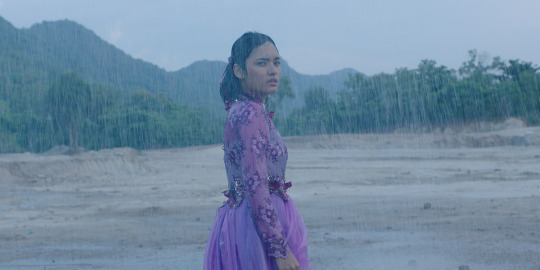
‘Yuni’, written by Prima Rusdi and Kamila Andini, directed by Andini.
We’ve got another question here from David, who says their favorite films are humanistic dramas, citing Hirokazu Kore-eda as one of their favorite directors. Would anybody have any recommendations for David?
CB: I can recommend at least one film, called Yuni, an Indonesian film from Kamila Andini. This is a naturalist drama about a high-school girl who is one of the top students in her class, and has a great group of friends. We slowly begin to see that her life is being constrained by one man after another, and then something happens at school, which begins to narrow her possibilities for her future. She’s trying to figure out things like sexuality and romance and what she wants to do with her future, and all of these obstacles keep getting placed in her path. It’s told in a very gentle way, but very incisive as well. Each scene really matters, taking you deeper inside this girl’s life.
RC: Our senior programmer Giovanna Fulvi programmed a film called Aloners, a South Korean film by Hong Sung-eun. This is her first feature, and it’s very much a film of our time. It is about a woman who works in the gig economy at a credit-card customer-service call center. It’s a very transient existence. She doesn’t talk to anybody, she eats by herself, she doesn’t really want to associate with the people in her apartment building. One day, one of her neighbors who has tried to talk to her many times passes away, and she has to re-interrogate the way that she’s been living her life, and figure out if it’s worth starting to form some human connections.
Next up is a question from Matt Neglia, from the Next Best Picture podcast. Matt says that he’s a massive fan of epics, whether they’re three hours long or just telling an expansive story with lots of world-building. Apart from Dune, are there any other films in the lineup that you would describe as epic?
CB: While Joachim Trier’s The Worst Person in the World might not strike you on reading its synopsis as an epic, I think it actually is an emotional epic. It’s the story of a young woman who’s trying to figure out her life. Her romance with one boyfriend doesn’t quite fit the bill for her, and she begins this looking and exploring. Trier and his writer and lead actor do remarkable work, blowing open the idea of a person trying to define who they are at this turning point in their life. They make these stakes massive and they have all kinds of interesting, innovative, formal elements in [the film] as well. It’s incredibly cinematic. If you’ve seen Joachim Trier’s other films, this is kind of the conclusion of a trilogy that he’s made.

‘Listening to Kenny G’, directed by Penny Lane.
Next up, we have Sarah, who is looking for movies about music, and also some body horror.
CB: We’ve got a number of great music docs this year. I have to mention Dionne Warwick, the queen of Twitter, who is the subject of Dionne Warwick: Don’t Make Me Over. It tells the story of this incredibly talented, determined and glamorous musician who broke so many barriers. She toured in the south during the Jim Crow era, making gains as a Black woman in the music industry and in the pop-music industry, not the so-called race-record or Black-music industry, which simply wasn’t done at the time. This documentary tells that story, and also shows her later work in the ’80s contributing to the fight against stigma and hysteria during the AIDS crisis.
PK: I’ll follow up Cameron by mentioning the Alanis Morissette film Jagged. We’ve also got a film about the great jazz pianist, Oscar Peterson, called Oscar Peterson: Black + White. Lastly, there’s a film about Kenny G, called Listening to Kenny G.
Diana Sanchez: For the body horror, I’d like to mention the debut film by Ruth Paxton, titled A Banquet. It’s about a young woman who insists her body is no longer her own, and is a service to a higher power. Her mother has no idea what to think. She stops eating, and her mother doesn’t know [whether] to believe her or not. I love Ruth Paxton’s work, the way she shoots the film, the way she shoots the food. It’s almost, as she refers to it, pornographic. It looks delicious and gross all at the same time.
I’d also like to flip to comedy quickly to mention Official Competition. The film stars Penélope Cruz, Antonio Banderas and Oscar Martínez. Cruz plays a filmmaker who puts together a well-known theater actor and a well-known box-office glamor guy, played by Banderas. The film speaks to the tension between high art and more popular art, testing those boundaries. It’s incredibly funny.
We’d love to squeeze a few more films out of everyone for our watchlists. Could you each recommend one film and try to sell it in ten words or less?
CB: Let me try. Sundown, by Michel Franco. Tim Roth falls apart beautifully in Mexico.
TP: I’m going to go with the Mexican documentary, Comala. Filmmaker Gian Cassini explores the legacy of his father, who was a Tijuana hitman.
PK: I’ll go with Saloum, which is basically From Dusk Till Dawn in West Africa.
RC: I’m going to say The Wheel, a movie by Steve Pink. If you like Who’s Afraid of Virginia Woolf?, this is like that with a younger couple in a much more humane, intimate key.
DS: I’ll say I’m Your Man, a sci-fi where Maren Eggert dates a robotic Dan Stevens.
PK: I know Diana has been recommending a film called OUT OF SYNC, about an artist who begins to experience the sound of the world going out of sync. She starts hearing sounds from the past because people and things are out of sync with their surroundings.
NHY: I’ll go with The Gravedigger’s Wife, directed by Khadar Ahmed. It showcases the horn of Africa unlike you’ve ever seen it on screen.
Finally, for Cameron: with fall coming, what is the best TIFF 2021 movie to watch under a blanket, either because it’s cozy or because you’re terrified, or both?
CB: Great question, which gives me a chance to talk about Earwig, the new film by Lucile Hadžihalilović. If you’ve seen Innocence or Evolution, her two most recent films, you’re prepared in terms of tone, but you’ve not even seen Lucille make a film quite like this. It’s eerie, disturbing, hypnotic, mesmerizing. You can’t stop watching, but you’re always afraid that something awful and horrifying is about to happen… and maybe it might.
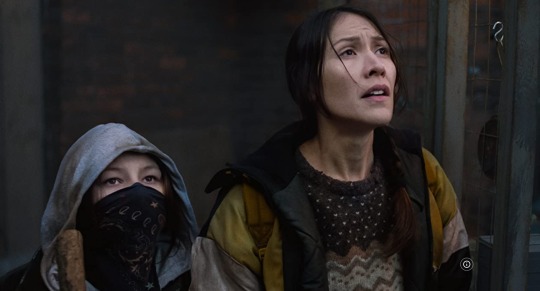
‘Night Raiders’, written and directed by Danis Goulet.
To bring it all back home, what would you say is the Canadian film of 2021?
CB: It’s always hard to say, but I think in a year where we have Danis Goulet’s feature Night Raiders, that’s got to be the one. Danis has made some exceptional short films over the last few years that people might know. Her feature takes on the horrific, devastating story of residential schools and children torn from Indigenous families and put in institutions where the goal was to erase their Indigenous identity. She takes that terrible, real history that we’re grappling with right now in Canada, and turns it into a piece of speculative fiction, a kind of propulsive thriller.
By turning it into fiction rather than reality she can use all of the tools of cinema to tell a terrific story that’s exciting and has high stakes, but also has this deep resonance of a truth that we are, I hope, coming to terms with in this country.
The Toronto International Film Festival runs from September 9 to 18. This conversation has been edited for length and clarity. Follow TIFF on Letterboxd, and follow our Festiville HQ for regular festival updates.
#tiff#tiff21#tiff 21#tiff 2021#toronto#toronto international film festival#cameron bailey#midnight madness#jessica chastain#jane campion#benedict cumberbatch#saul williams#danis goulet#canadian film#letterboxd#festiville#letterboxd festiville#gemma gracewood#thom powers#nataleah hunter-young
3 notes
·
View notes
Photo
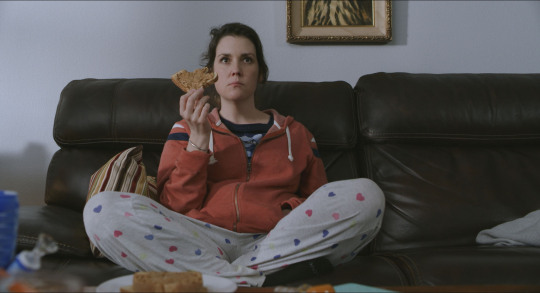
Slovenly Creatures.
A Life in Film chat with Letterboxd fave Melanie Lynskey about fart jokes, comfort comedies, foundational film idols and her obsession with Kevin Hart.
“Not all the plot points have to tie together, it doesn’t have to make sense, it doesn’t have to be perfectly sharp. It just has to be funny, that’s all.” —Melanie Lynskey
Search through Letterboxd and you’ll find that New Zealand-born Melanie Lynskey has a special place in the hearts of film lovers. Lists dedicated to “my favorite actress”, “the least-appreciated currently working character actress”, “lovely Melanie Lynskey films”. Reviews that consist mainly of Melanie Lynskey’s name, over and over again. And so it is with her latest film, Lady of the Manor. Reviews of the ghostly, farty buddy-comedy are united on one thing: Melanie Lynskey.
Her secret involves a smart straddling of the indie-mainstream fence, one foot in comedy, the other in drama, and a weathered eye on the politics of her industry. Follow her Twitter account, and you’ll see that Lynskey’s tastes and influences are wide-ranging. She is a hungry devourer of recaps, a staunch ally of the marginalized, and generous with her praise of great work (including those she works with).
But for Letterboxd fans, it is simply about what Lynskey herself brings to every role, whether that be character parts in cult camp like But I’m a Cheerleader and Coyote Ugly, or as a devoted participant in 21st-century indie fare, often involving the Duplass brothers, and often with long, existential titles, or as a rock-solid addition to A-list ensemble adventures such as Up in the Air, The Informant! and Mrs. America.
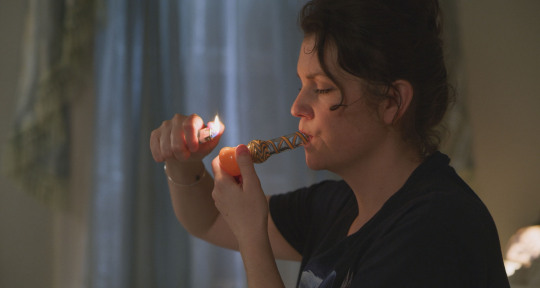
Melanie Lynskey sparks up in ‘Lady of the Manor’.
“I have said it before and I will keep saying it until I lose my figurative online voice,” writes Lynskey stan Fred, “Melanie Lynskey is one of the best working actors and Hollywood needs to catch up yesterday.” She has been serving lesbians since her 1994 break-out in Peter Jackson’s Heavenly Creatures. She is the Queen of Indie. She is a gift. She can do no wrong. She is our spirit animal.
For Lynsksessives, a new Melanie Lynskey season is upon us. A Showtime series, Yellowjackets, in November. In December, she will be seen in Adam McKay’s starry new astronomy caper, Don’t Look Up. And right now, those hunting for a charming indie comedy led by our favorite goofball need look no further than Lady of the Manor, from brothers Justin and Christian Long.
“I wanted ghost Judy Greer interacting with stoner Melanie Lynskey and I got ghost Judy Greer interacting with stoner Melanie Lynskey,” writes Owen, of the supernatural buddy comedy in which hot mess Hannah (Lynskey) is haunted by prim and proper (and probably murdered) Lady Wadsworth (Greer), while trying to hold down a job as a tour guide at Wadsworth Manor.
In order to help Greer’s uptight apparition find peace, Hannah must solve the mystery of the manor’s ownership. That, however, requires her to overcome an extreme lack of ambition, terrible personal hygiene, and sleazy advances from a toxic and horny Ryan Philippe. Angela Alise and Luis Guzmán pop up in somewhat underwritten supporting roles, but Lady of the Manor is, above all, a buffet of physical comedy delights for Lynskey lovers.
Letterboxd editor-in-chief Gemma Gracewood jumped on the line with Lynskey for a laugh and a cry about David Lynch movies, the late Katrin Cartlidge, teen obsessions, and being a responsible Academy voter.
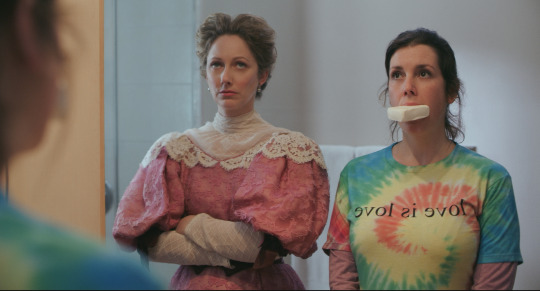
Lady Wadsworth (Judy Greer) serves some manners to her re-enacting dopplegänger, Hannah (Melanie Lynskey).
Lady of the Manor feels like a Pygmalion situation, you know? My Fair Lady, but you are Eliza Doolittle and Judy Greer is Professor Henry Higgins, and the transformation is actually not that huge: Hannah goes from this complete stoner to still a complete stoner, but maybe with a few additional life goals.
Melanie Lynskey: That was the thing that really sold me on the movie, honestly, was that she just didn’t really change that much. The moment that I was, like, ‘I’m going to do this movie’ was when she’s all inspired—“I’m going to return the house to its rightful owner”—and she marches off purposefully, and then it cuts to her at the bar and she’s just wasted again. It was so funny to me. ‘Oh wow, they’re really letting her be a mess. They’re not trying to redeem this person.’
You and Judy Greer have an insane chemistry. Can you share some insights into that working partnership?
It was so much fun. We’ve never gotten to work together, because it’s always: she’s doing the role, or I’m doing the role, or Kathryn Hahn is doing the role. There’s usually one part that’s right for us in a movie, and so, to have two different roles that are right for both of us, it was such a dream.
A lot of it is on the page, because Justin and Christian worked so hard on the script, and it was at a point that they were really, really happy with it, and they were very fond of a lot of the jokes. We did get to add little things here and there. We got a lot of freedom and a lot of room to improv.
Who is the best movie ghost, apart from Judy Greer?
All I can think of is Ghost. Oh, Beetlejuice. There you go. That’s an amazing ghost, that’s a great movie.
What else should we watch Judy Greer in?
Who can name only one favorite Judy Greer performance?! She’s so incredible! The ones that come to mind are Adaptation, The TV Set, Jeff Who Lives At Home and Three Kings. She is a marvel—beautiful, funny, kind, smart, an amazing improviser and a great friend.
What is the film that first made you aware that filmmaking is something you could do, as opposed to watch?
I don’t really know what film made me aware of what filmmaking was! I always knew I wanted to be an actor, since I was about six years old and did a school play. I didn’t really watch a ton of movies as a kid. My parents were not really movie-goers. When I was about thirteen I started watching Twin Peaks, and from there I saw Blue Velvet and Wild At Heart, and that was the beginning of me realizing what kind of work really excited and interested me. So for 30 years now, I’ve had a dream of working with David Lynch.
And I started to try to watch everything that certain actors did. I got very obsessed with Katrin Cartlidge, who became my favorite actor. I loved her in Mike Leigh’s Naked and Career Girls, in Lars Von Trier’s Breaking The Waves, Lodge Kerrigan’s Claire Dolan and Milcho Manchevski’s Before The Rain. Through following Katrin’s career I started to piece together what I wanted my own to look like. She made incredible choices and was just so different and so good in every performance.
I was lucky enough to work with her before she passed; we did a movie of The Cherry Orchard and worked together for three months. I will cherish those memories forever. She was maybe an even more amazing person than she was an actor, and that is really saying something.

A publicity still from ‘The Three Musketeers’ (1993) with Oliver Platt, rear left, as Porthos.
What was the first film that gave you teenage feelings?
Well, I was a bit of a goth as a teenager. When I saw Alison Maclean’s short film Kitchen Sink, that was a big moment for me. I was like, wow. If I could make a movie that would express my soul at this moment, it would be this film. And I have loved all her movies since that one. The Rehearsal was so good! And Jesus’ Son. I keep hoping I’ll get to work with her.
As a teen I was very swoony over Oliver Platt. He was my number one crush. So any Oliver Platt film had me feeling some things—Flatliners and The Three Musketeers, especially. I’m still swoony over him today, to be honest.
What is the next hidden gem that you think Letterboxd members should watch?
My two favorite movies in recent memory are Shannon Murphy’s Babyteeth and Remi Weekes’ His House. Eliza Scanlen is absolutely glorious in the former. It’s a really deep and beautiful performance. Her parents are played by the incomparable Ben Mendelsohn and Essie Davis, both of whom destroyed me. The whole movie destroyed me. But my favorite performance in the movie comes from Toby Wallace, as the young-but-older love interest of Eliza Scanlen’s character. My god, this is an electric performance. He’s unbelievably good in it. Emily Barclay is great in it too. The movie is funny, heartbreaking and beautifully directed. The music is amazing.
And His House is just great. A really creepy, twisty thriller with a very tragic story at its center. It’s about a refugee couple who have escaped from South Sudan and are moved into housing in England, and the house is torturing them. It’s the most compelling movie I’ve seen in such a long time. The two leads, Wunmi Mosaku and Sope Dirisu, are flat out movie stars. You can’t take your eyes off either of them and the performances resonate on a thousand different levels. They’re astounding, and it’s incredibly accomplished filmmaking. Please please see these movies.
Because you’re from New Zealand, we’d be remiss not to ask what’s a must-see New Zealand film in your opinion?
If we’re talking about silly, fun comedies, and also women being funny and silly, I really love The Breaker Upperers. That was very, very, very charming and hilarious to me. I hope that more people see that.
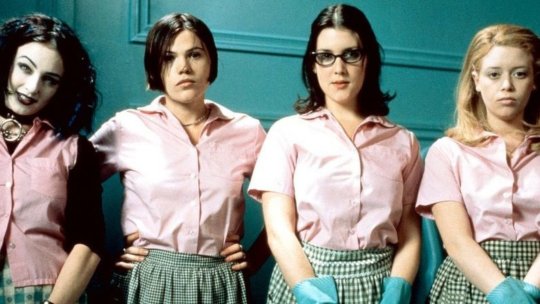
Katharine Towne, Clea DuVall, Melanie Lynskey and Natasha Lyonne in ‘But I’m a Cheerleader’ (2000).
For anyone still sleeping on Letterboxd favorite But I’m a Cheerleader, in one sentence, why should they watch it?
Oh, because it’s a campy romance with an amazing cast. It’s Clea DuVall and Natasha Lyonne falling in love with each other, it’s sexy, it’s sweet, it’s genuinely funny. It’s beautiful to look at. That’s not one sentence, that’s about twelve sentences, sorry. I’m so proud of that movie, I love that movie so much.
It’s an interesting one. It’s been growing in stature around here over the years, and I love to see it.
Yeah, very much. The reviews were outright negative when it came out.
What was the last film that made you cry, either because it was so sad, or because you were cry-laughing, or any definition of tears being shed?
Mm, gosh, the last film that made me cry… Oh, do you know what? I really cried at the end of Another Round, where he’s dancing.
That ending.
I’m going to cry. Sorry, it really got me. And also knowing what Thomas Vinterberg had been through, just the joy that was in that moment, the idea that you can just go through all this, and still have these moments of joy, and return to this person that you were before all this life happened to you. Just the purity of that moment really, really got me.
And not to mention just the sheer joy of Mads Mikkelsen dancing.
Yeah, god, just the beauty of that man in that moment and, ugh, god, what a great movie.
What mindfuck movie changed you for life?
It would probably be La Cérémonie. I had kind of a one-two punch of being introduced to Isabelle Huppert with La Cérémonie and Amateur, and it’s been true love ever since. I was like, who is this and what else can I see her in immediately??
I don’t know if La Cérémonie is a mindfuck but it’s definitely very dark and it gets really crazy! Sandrine Bonnaire is amazing in it too. But the first time I got to see the incredible intensity and commitment of Isabelle Huppert is really a moment I’ll never forget. It feels like there is a before and after for me.
Finally, some Letterboxd members have described the joy Lady of the Manor has brought them in the midst of an ongoing pandemic. As Robert writes, “I’ll watch Melanie and Judy ham it up for an hour and a half, and be fine with that. Some of the lame jokes in this have made me laugh harder than most films I’ve seen this year.” When it comes to the role of comedy in a crisis, what are the cozy, comfort re-watches that have kept you going through the pandemic?
Aw. I have a toddler, so we’re not watching too many movies. Around the time of the Academy Awards, I really buckled down, because I wanted to be a responsible voter, and I tried to watch everything. So, that was the most movies that I’ve done in a concentrated period of time, but none of that was really “comfort” feeling.
The movies that I do return to, when I feel like I have time to just chill out: Wet Hot American Summer is a big comedy movie for me. Justin did this really weird movie called Strange Wilderness with Steve Zahn and Jonah Hill years ago that is so weird and funny, I really love that one. All the Christopher Guests, like Waiting for Guffman, Best in Show, those are my go to.
And then Kevin Hart. I’m a big, big, big Kevin Hart fan. There are times I’ll be on a plane and I’ll think, “Oh, I should really watch this movie that I’ve been meaning to watch.” But if there’s a Kevin Hart movie, no chance, that’s what I’m going to watch. I’ll go to the movie theater opening weekend to see a Kevin Hart movie. Kevin Hart right now is making a movie with Regina Hall. I’ve seen it on their Instagrams, and I’ve never been more excited for a film.
What is it about Kevin Hart for you?
He is a comedic genius. He is absolutely brilliant, and he will do something in almost every scene that surprises me, and it’s crazy. He can be doing something that’s a real rote, by-the-numbers movie—they’re not all masterpieces—but he makes it new, and interesting, and surprising. Nobody reacts better than Kevin Hart, he is such a funny reactor. He’s always in the moment, I think he makes other people funnier and better. I’m obsessed, I love him.
It’s reassuring to hear you say “they’re not all masterpieces”, because I think comedy is so hard. It is so hard to reach for a five-star comedy, but the truth is that we’re all happy in a sort of three-star comedy world. Those are the films we return to again and again.
Of course! Yeah, and that’s all you’re hoping for with, especially, a silly comedy. You just hope that there’s enough moments that people laugh, and feel like they’ve got a good laugh, and they’ve relaxed for a while. Not all the plot points have to tie together, it doesn’t have to make sense, it doesn’t have to be perfectly sharp. It just has to be funny, that’s all.

Lynskey, as Hannah, with ‘Lady of the Manor’ director and co-writer Justin Long as Max, her academic love interest.
On that note, the Long brothers call this “a fartwarming comedy”, and several Letterboxd reviews comment on Lady of the Manor having “the single best fart joke in ages” or “just the right amount of fart jokes”. Why are farts so funny, Melanie Lynskey?
Do you know what? I don’t find them funny at all, I really don’t. I’m a little bit prissy and there are things in this movie where I was like, “You’re just going to have to tell me exactly what to do.” Like the farting in the room, and burps and stuff like that, I’m not good at that stuff, but people think it’s funny. I don’t know. It’s kind of beyond me…
Wow, so you really exercised your acting muscles on this.
Exactly, exactly, it’s the greatest performance of my life!
Related content
Eileen’s list of gay ’90s movies starring Melanie Lynskey
Mystery Thriller’s list of stoner comedy films
Horny Ghosts—a list by Carlos vs. the Wolf Man
Antoniaaa’s list of female buddy movies
Rent Alison Maclean’s Kitchen Sink and The Rehearsal
Follow Gemma on Letterboxd
‘Lady of the Manor’ is available now on VOD, Blu-ray and DVD. ‘Don’t Look Up’ is in select theaters from December 10, and on Netflix on Christmas Eve.
#melanie lynskey#justin long#judy greer#lady of the manor#comedy#buddy comedy#buddy movie#female buddy movie#adam mackay#steven soderbergh#yellowjackets#don't look up#heavenly creatures#peter jackson#letterboxd
22 notes
·
View notes
Photo
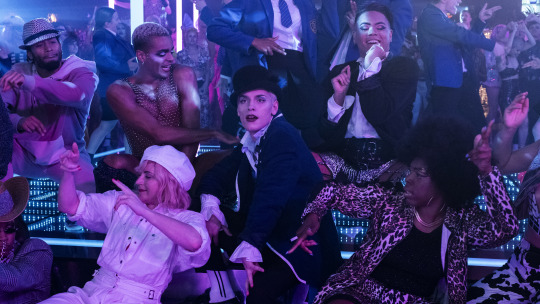
Wigging Out.
Choreographer and director Jonathan Butterell tells Gemma Gracewood about stepping behind the camera for Everybody’s Talking About Jamie, his love for Sheffield, and making sure queer history is kept alive. Richard E. Grant weighs in on tolerance and Thatcher.
Of 2021’s many conundrums, one for musical lovers is why the narratively problematic Dear Evan Hansen gets a TIFF premiere and theatrical release this month, while the joyously awaited Everybody’s Talking About Jamie went straight to Amazon Prime.
And yet, as the show’s lyrics go, life keeps you guessing, along came a blessing. There’s something about the film streaming onto young people’s home screens, with its moments of fourth-wall breaking where Jamie speaks straight to the viewer, that feels so important, given the content: a gay teen whose drag-queen destiny sits at odds with the less ambitious expectations of his working-class town.
Director and choreographer Jonathan Butterell, who also helmed the stage production (itself inspired by Jenny Popplewell’s 2011 BBC documentary, Jamie: Drag Queen at 16) agrees that the worldwide Amazon release is a very good silver lining. “I made the film for the cinema but, in 250 territories across the world, this is going to have a reach that—don’t get me wrong, cinema, cinema, cinema, collective experience, collective experience, collective experience—but it will get to people that it might not have got to before.
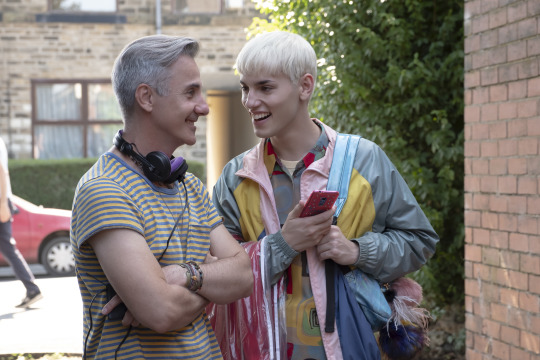
Jonathan Butterell on set with star Max Harwood, as Jamie.
“It feels as niche a story as you could possibly be. But also for me, I wanted it to feel like a universal story, that it didn’t matter where on any spectrum you found yourself, you could understand a young person wanting to take their place in the world freely, openly and safely.”
Everybody’s Talking About Jamie, with screenplay and lyrics by Tom MacRae and songs by Dan Gillespie Sells, sits neatly among a series of very specific feel-good British films about the working class experience, such as Billy Elliot, Kinky Boots and Pride. The film adds some historical weight to the story with a new song, ‘This Was Me’, which allows Jamie’s mentor, Hugo (played by Richard E. Grant), to take us into England’s recent past—the dark days of the discriminatory Section 28 laws, at a time when the HIV/AIDS epidemic was still ravaging the community.
Hugo’s drag persona Loco Chanelle (played in the flashback by the stage musical’s original Jamie—John McCrea from Cruella and God’s Own Country), sports a wig that looks suspiciously like the Iron Lady’s unmistakable head of hair. Grant confirms that was Hugo’s intention. “His heyday was in the 1980s, so as a ‘fuck you’ to Mrs Thatcher, what better than to be dressed up like that, at six-foot-eight, with a wig that could bring down the Taj Mahal!”
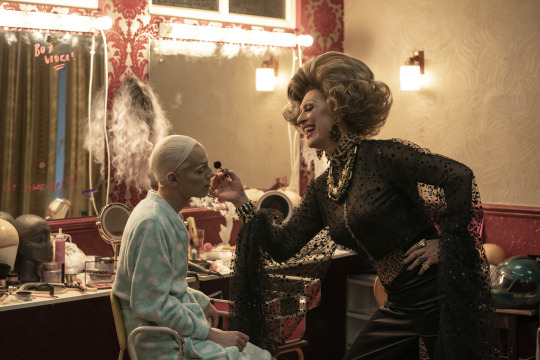
Richard E. Grant as Hugo, getting to work on Jamie’s contours.
In light of the current pandemic, and the fact that the 1967 legalization of homosexuality in Britain is only “an historical blink away”, Grant’s hope is for more tolerance in the world. “Maybe Covid gives people some sense of what that was like, but with Covid there’s not the prejudice against you, whereas AIDS, for the most part in my understanding, was [seen as] a ‘gay disease’, and there were many people across the globe who thought that this was, you know, whatever god they believe in, was their way of punishing something that they thought was unacceptable.
“The message of this movie is of inclusivity, diversity, and more than ever, tolerance. My god, we could do with a dose of that right now.”
Read on for our Q&A with Jonathan Butterell about the filmic influences behind Everybody’s Talking About Jamie.
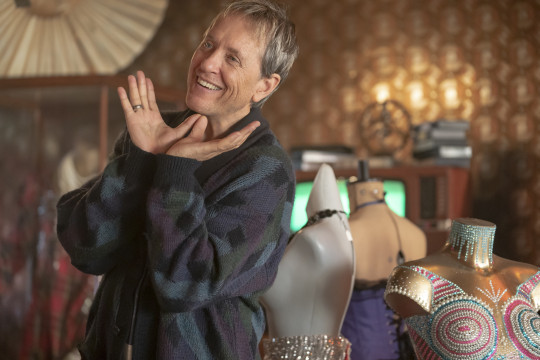
Hugo in a reverie, surrounded by his drag menagerie.
Can we talk about the new song, ‘This Was Me’, and the way you directed it in the film? It’s a show-stopper, with Richard E. Grant singing in that beautiful high register, and then moving into Holly Johnson’s singing, as you go back in time to show that deeply devastating and important history.
Jonathan Butterell: It felt inevitable, the shift, and necessary. Myself, Dan Gillespie Sells, the composer, and Tom MacRae, the screenwriter, we created this piece together, the three of us, and it’s a film by the three of us. We lived through that time, we went on those marches. Actually, in one of those marches [shown in flashback], Dan’s mum—actual mum—is in a wheelchair, by a young boy who was holding a plaque saying “my mum’s a lesbian and I love her”.
That is Dan with his mum back in the day, and it all speaks to our stories and it moves me, I can see it’s moving you. It moves me because I lived through that time, and it was a complex time for a young person. It was a time that you felt you had to be empowered in order to fight, and you felt very vulnerable because of the need to fight. And because of that disease, because HIV was prevalent and we lost people—we lost close people—it was a difficult time. I wanted to make sure that that story kept being told and was passed on to the next generation.
It’s so important isn’t it, to walk into the future facing backwards?
It still exists, that need to fight still exists. The conversation, yes, has moved on, has changed, but not for all people and not in all communities.
What would be your go-to movie musical song at a karaoke night?
My goodness. There’d be so many.
I mean, is it going to be a Cabaret, a Chicago showstopper, or something more Mary Poppins, something from Rent?
I think what I would go to, which is what I remember as a little boy, is Curly singing ‘Oh, What A Beautiful Mornin’. It’s such a kind of perfect, beautiful, simple song. That, and ‘The Lonely Goatherd’, because I just want to yodel. It would be epic. Trust me.
What is the best film featuring posing and why is it Paris Is Burning?
It’s always Paris Is Burning. Back in the day, I was obsessed with Paris Is Burning, I was obsessed with that world. In fact, at one moment I even met [director] Jennie Livingston in trying to make a theater piece inspired by that. I lived in New York for eleven years and I met Willi Ninja. I just adored everything about him, and he would tell me stories. And again, it was so removed from the boy from Sheffield, I mean so far. That New York ballroom scene was so removed from my world, but I got it. Those two boys at the top of the film, I just wanted to be one of those boys who just hung out outside the club.
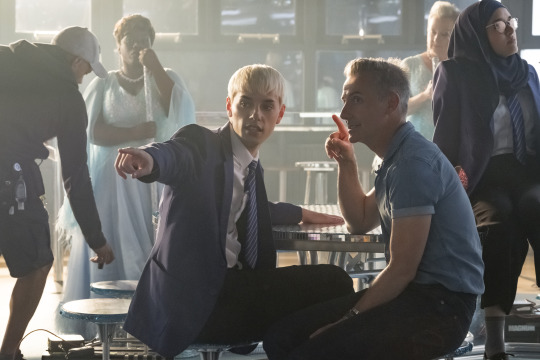
Harwood and Butterell on set, with Lauren Patel (right) as Jamie’s bestie Pritti Pasha.
What films did you and Tom and Dan look at to get a feeling for how to present the musical numbers?
Actually, a lot of pop videos, from present day to past. There’s an homage, in the black-and-white sequences, to a little ‘Vogue’ Madonna moment. Pop is very central to me in this story because pop is what a working-class kid from a working-class community will be listening to. That’s in his phone, that’s in his ears. Not that many young people listen to much radio at this moment in time, but that’s what will be on Margaret’s radio, that’s what’s coming into the kitchen. And that was central to the storytelling for me.
Bob Fosse also really influenced me, and particularly All That Jazz and where his flights of imagination take him. I felt that was so appropriate for Jamie, and again in a very, very different way, but I could see how Jamie’s imagination could spark something so fantastical that would lead him to dance, lead him to walk on the most amazing catwalk, lead into being in the most fabulous, fabulous nightclub with the most amazing creatures you’ve ever met in your life.
For me personally, the film that most inspired me was Ken Loach’s Kes, because that is my community. Both the world in which Jamie exists—Parsons Cross council estate, is my world, is my community—and the world of that young boy, finding his place in the world with his kestrel friend, I remember identifying with that boy so clearly. He was very different from me, very different. But I got him, and I felt like Ken Loach got me through him.
Ken Loach made a few films set in Sheffield, didn’t he? But also, Sheffield is a setting and an influence on The Full Monty, The History Boys, Funny Cow and that brilliant Pulp documentary. So Jamie feels like a natural successor.
It absolutely does. Sheffield’s where I grew up, it’s my hometown. Although I moved away from it, I always return. To have a chance to celebrate my community, and particularly that community in Parsons Cross council estate. If you’re in Sheffield and you’re in a taxi and you said, “Take me to Parsons Cross,” they’d say, “Well, I’ll drop you there, but I’m not staying.” Because again there’s a blinkered view of that community. And I know that community to be proud, glorious and beautiful.
And yes, that community, particularly through the ’80s, really suffered because some of that community would serve the steelworks and had three generations of unemployment, so they became disenfranchised because of that. But the community I grew up in, my Auntie Joan, who lived on that road, literally on that road, was a proud, working class, glorious woman who served chips at school.
Aside from Everybody’s Talking About Jamie, what would be the most important queer British cinematic story to you? (And how do you choose between My Beautiful Laundrette and God’s Own Country?!)
You can’t. My Beautiful Laundrette influenced me so much because, one, Daniel Day Lewis was extraordinary in that film, and two, because of the cross-cultural aspect of it. I went, “I know this world”, because again I grew up in that world. And it affirmed something in me, which is the power and the radicalness of who I could be and what I could be.
With God’s Own Country, when I saw that film—and that was Francis’ first film, which I thought was extraordinary for a first-time filmmaker—I knew he knew that world from the inside, from the absolute inside. And I know what that rural community was like. I read that script, because we share agents, and I was blown away by it—again, because of the two cultures coming together.

Jamie Campbell, the film’s real-life inspiration, with screen-Jamie Max Harwood.
Richard E. Grant’s character, Hugo, is such a pivotal mentor for Jamie. What did you need to hear from a mentor when you were sixteen?
Don’t let yourself hold yourself back, because I think it was me who put some limitations on myself. And of course I came from a working-class community. I was a queer kid in a tough British comprehensive school. And did I experience tough times? Yes I did. And did I deal with those tough times? Yes I did. But the song that speaks to me mostly in this is ‘Wall in my Head’, in which Jamie takes some responsibility for the continuation of those thoughts, continuations of the sorts of shame, and that’s a sophisticated thing for a sixteen-year-old boy to tackle.
I also was lucky enough to have a mother like Margaret—and a dad like Margaret as well, just to be clear! And I remember my mum, at seventeen when I left home, just leaving a little note on my bed. It was quite a long letter. She said, Jonathan, you’ve probably chosen to walk a rocky path, but don’t stray from it, don’t steer away from it. That’s the path you've chosen, there may be rock-throwers along the way, but you’ll find your way through it. That stayed with me and I think that’s what resonates with me. And when I saw that documentary, Jamie: Drag Queen at 16, I felt that that sparked the need for me to tell that story.
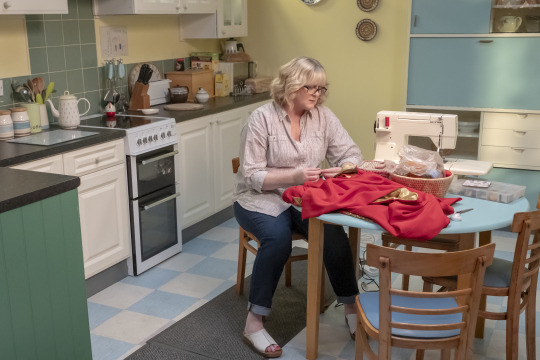
Sarah Lancashire as Jamie’s mum, Margaret New.
We need more mums and dads like Margaret, don’t we?
We do, we do. And the wonderful thing is, Margaret Campbell will say it and I think Margaret New in the film will say it: she’s not a Saint, she’s an ordinary mum. And she has to play catch up and she doesn’t understand in many ways, and she gets things wrong and she overprotects. But she comes from one place and that is a mum’s love of her child and wanting them to take their place safely in the world and to be fully and totally themselves.
Related content
Eternal Alien’s list of films Made in Sheffield
Letterboxd’s Camp Showdown
Persephon’s list of films recommended by drag queens
Passion’s list of films mentioned by Jaymes Mansfield in her Drag Herstory YouTube series
Follow Gemma on Letterboxd
‘Everybody’s Talking About Jamie’ is streaming now on Amazon Prime Video.
#everybody's talking about jamie#max harwood#john mccrae#richard e. grant#sharon horgan#jonathan butterell#musicals#drag queen#queer film#lgbtqia cinema#british cinema
18 notes
·
View notes
Photo

Halfway—2021.
Two Filipino indies lead the Letterboxd Top 25 at the 2021 halfway point, as the coronavirus pandemic continues to shake—and reshape—the film industry. Jack Moulton and Gemma Gracewood take stock.
Cleaners, Glenn Barit’s photocopied, hand-colored, stop-motion feature about high schoolers in the northern Philippines city of Tuguegarao, is the highest-rated 2021 film on Letterboxd at the halfway point of the year, with a weighted average of 4.3 out of 5 stars. Ode to Nothing, by Barit’s fellow countrywoman Dwein Baltazar, is in second place, and Shaka King’s two-time Oscar-winner Judas and the Black Messiah rounds out the top three.
Last year was a transition year in many ways: for the world, a pandemic-led move away from cinema screenings to at-home virtual theaters and streaming-first releases; for Letterboxd, a move away from US-led release dates in our annual calculations. This has opened the way for notable films from around the world to be included on our lists far sooner than their oft-delayed American releases (which had resulted in, for example, Brazil’s Bacurau not making the 2019 Letterboxd Year in Review).
Both of these factors help to explain why we have two Filipino independent features leading our midway Top 25. “Cleaners and Ode to Nothing are exactly the kind of small Filipino films that would have struggled to get national distribution in theaters in the before times, despite the buzz that they garnered,” writes Manila-based film critic Philbert Dy in his companion essay to the Top 25, in which he explains how the Philippines’ particularly long and harsh Covid lockdown has “led to smaller, quirkier films being made accessible to more Filipinos, whose consumption of cinema were once beholden to the whims of conglomerate cinema owners”.

‘Cleaners’, written and directed by Glenn Barit.
When we shared the good news with him, a delighted Cleaners director Glenn Barit specifically shouted out his nation’s film lovers: “It is a testament to a vibrant Filipino film community still actively watching and supporting films of our own. Especially with a film like ours set in a small city far from the capital, it is amazing to read in reviews that it resonates with a lot of people (sometimes even outside our country).”
From this year forward, our mid-year rankings include films that have been released in any country, with at least a limited theatrical, streaming or video-on-demand run, and a minimum of 1,000 views on Letterboxd. These new rules allow us to celebrate the love for Katie Found’s lesbian romance My First Summer—released in Australia in March—without having to wait for the US to catch up. It joins indie highlight Shiva Baby, Michael Rianda’s animated hit The Mitchells vs The Machines and Heidi Ewing’s swooning romance, I Carry You With Me, on the Top 25 in putting young, queer characters on the screen.
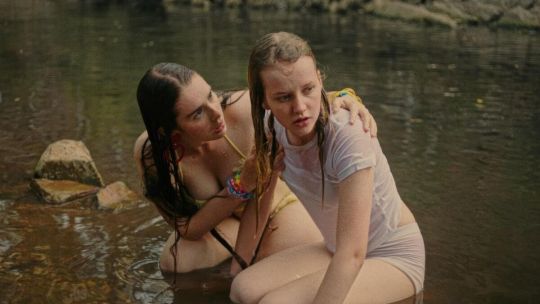
‘My First Summer’, written and directed by Katie Found.
As expected, many films on the list have suffered pandemic delays. We use premiere dates to mark the year of record for each film, so A Quiet Place Part II will always be attached to its March 2020 red-carpet screening, despite the fourteen-month hibernation that followed. This is Not a Burial, It’s a Resurrection by Mosotho director Lemohang Jeremiah Mosese screened at 2019’s Venice Film Festival and had a very long festival run until Mubi picked it up for streaming in the UK this year. The film’s lead, Mary Twala, passed away a year ago, July 4, 2020 (see her also in Beyoncé’s Black is King). Gabriela Cowperthwaite’s Our Friend—one of the eight women-directed films on the list—went to TIFF, London, and AFI before being released this January without screening once in 2020.
More than half of our Top 25 films are directed by BIPOC directors, nearly a dozen of whom are of Asian descent, illuminating a key benefit of the new eligibility system. Challenging the US for the most represented country is India with five films in the list, taking advantage of Amazon’s distribution deal and creating greater accessibility for Hindi, Tamil and Malayalam-language films at home and abroad.

‘Red Post Post on Escher Street’, written and directed by Sion Sono.
Also among the Asian directors making the list are legends Tsai Ming-liang and Sion Sono. Tsai’s Days recently received a limited run in Spain (it will be brought to the US by Grasshopper Films this August), while Sono’s Red Post Post on Escher Street had a quick VOD run in February courtesy of Japan Society Film.
Produced in the US and directed by Japanese-Brazilian Edson Oda, Nine Days qualifies due to an exclusive run at the Singapore arthouse theater The Projector in May—it’ll be released in the US later this month. Finally, Asian American director Jon M. Chu makes the list with his adaptation of Quiara Alegría Hudes and Lin-Manuel Miranda’s In the Heights. We are also happy to see a couple of Letterboxd members in the halfway 25: Cleaners’ Barit and Chad Hartigan (Little Fish). If you’d like to discover more 2021 releases by our member-filmmakers, we have a list for that.
The Top 25 is, of course, solely made up of narrative feature-length films. On the documentary front, Flee is currently the highest-rated non-fiction feature of 2021. Neon is expected to release the film in the US for an awards run later this year, but it’s eligible now due to a release earlier this month in director Jonas Poher Rasmussen’s homeland of Denmark.

‘Flee’, directed by Jonas Poher Rasmussen.
Fellow Sundance Film Festival winner Summer of Soul (or… When the Revolution Could Not Be Televised) is currently the year’s highest-rated documentary in general, but was 48 hours shy of eligibility for the halfway list, releasing in theaters and on Hulu on July 2. The runners-up are: Sir Alex Ferguson: Never Give In, directed by the notorious football manager’s son; David Attenborough’s The Year Earth Changed, directed by Tom Beard; and rock-docs TINA and (in his doc-directing debut) Edgar Wright’s The Sparks Brothers.
In other categories, It’s a Sin is the highest-rated narrative miniseries at the midway point, Can’t Get You Out of Our Head by Adam Curtis is the highest-rated documentary miniseries, Bo Burnham: Inside is the highest-rated comedy special, Blackpink: The Show is the highest-rated music film, Save Ralph is the highest-rated animated short film, and Four Roads, by Alice Rohrwacher, is the highest-rated live-action short film.
With Cannes underway and more festivals to come, it is still a long road to the 2021 Year in Review for these films—but given the journey most of them have already travelled, it is pleasing to celebrate the filmmakers’ success. Ang galing ninyong lahat!
On top of its meticulously bonkers production process, our highest-ranked film, Cleaners, had a long journey to its first theatrical distribution, and it’s far from over. The film premiered at the QCinema International Film Festival in October 2019, to raves from Filipino Letterboxd members, and it still holds a firm grasp on its high rating nearly two years later. Ultimately, the first non-fest release for Cleaners occurred when Singapore’s Asian Film Archive screened it for a week in April, thus qualifying the film for our 2021 lists.
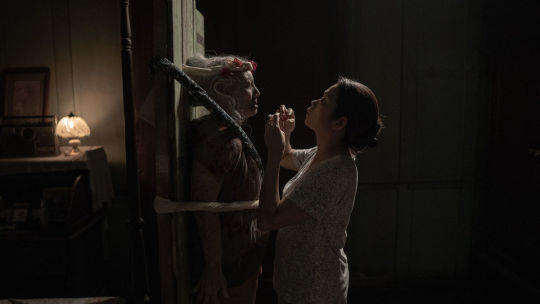
‘Ode to Nothing’, written, directed and edited by Dwein Baltazar.
Ode to Nothing has been on an even longer journey. The film also debuted at the QCinema Festival, but in 2018, and finally arrived on local streaming services iWantTFC and KTX.PH earlier this year.
Being celebrated by their countryfolk on Letterboxd is one thing, but how can those of us outside the Philippines see these top two films? Perhaps we need to give our local distributors a nudge. As Cleaners director Barit explains: “We are a team of three first-time filmmakers and producers. We are still learning the ropes of film distribution and marketing—and it’s been very hard. I just want to shamelessly say that our doors are wide open for distribution and acquisition; we are not yet available on any streaming platforms locally or internationally [winks nervously].”
youtube
See the Halfway 2021 list on Letterboxd and watch the Top 10 countdown on YouTube
Follow Jack and Gemma on Letterboxd
#letterboxd#letterboxd top 25#letterboxd 2021#cleaners#filipino film#philippines cinema#filipino cinema#glenn barit#sion sono#tsai ming liang#celine sciamma
30 notes
·
View notes
Photo

Lonesome Cruiser.
Blockbuster composer Tom Holkenborg, aka Junkie XL, talks to Gemma Gracewood about composing for titans, his pride in Dutch cinema, friendship with George Miller and longing for Olivia Newton-John. Plus: his Letterboxd Life in Film and why he’s selling his prized collection of recording gear.
It has been a spectacular spring for Tom Holkenborg, the Dutch musician also known as Junkie XL, who has crafted the scores for multiplex fare such as Mad Max: Fury Road, Deadpool, Terminator: Dark Fate, Sonic the Hedgehog and the upcoming zombie banger Army of the Dead. Only weeks apart, two blockbusters landed on screens with his sonic stamp all over them: Adam Wingard’s Godzilla vs. Kong and Zack Snyder’s re-realized Justice League.
Thankfully, the Godzilla vs. Kong score was complete by the time the Justice League telephone rang. Holkenborg—who had lost the Justice League gig along with Snyder the first time around—knew the Snyder cut was coming; he had closely watched the growing calls for it online. “Zack and I already started talking in 2019. He’s like, ‘What if we were to finish this? What would it take?’ Those conversations turned to ‘Well, how many recording days potentially do you need and how much of an orchestra do you potentially need?’ Finally, somewhere in April 2020, that’s when that phone call came: ‘Okay, light’s green, start tomorrow, and start running until it’s done because it’s four and a half hours’.”
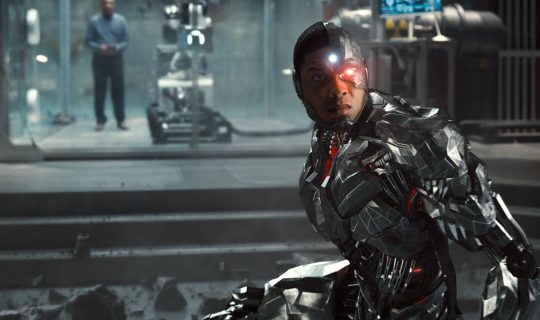
Ray Fisher as Cyborg in ‘Zack Snyder’s Justice League’.
Holkenborg approaches the titanic task of blockbuster film scoring with an engineer’s mindset: “Building a fantastic, huge house with 20 bedrooms and the dance hall and the kitchen… You’re not going to start by building the third bathroom for the third guest room, right?” Once he has identified the scenes that are most important to his directors—for Snyder, they included the introduction of Cyborg, three fight set-pieces, and a scene of The Flash running that comes towards the end of the film—the composer identifies instrumental “colors” in order to build a theme around each character. Then he holds some of those colors back, theorizing that “if you want like an, ‘Oh!’ experience by looking at a painting that has a huge amount of bright yellow in it, it’s way more successful to see fifteen paintings in front of it, where yellow is absent.”
The Godzilla vs. Kong score satisfies Holkenborg’s life-long love of both characters. “I don’t have a preference for either one. I love them both for various different reasons.” Their respective histories fascinate him: Godzilla as a way to make sense of Japan’s nuclear fall-out, and Kong as a gigantic spectacle that ended up attracting the sympathies of the audiences he was supposed to scare. Even when the science makes no sense (“what the fuck are plasma boosters, anyway?!”), Holkenborg is still happy to wax lyrical about the emotional depth of Kong’s stories, the elaborate concepts of the Godzilla-verse, and his musical approach to the pair—dark, moving brass for Godzilla, with synthesized elements “because he is a half-synthesized animal”, and a more organic, complex orchestration for Kong, featuring “one of the world’s bigger bass drums”.

Adam Wingard’s ‘Godzilla vs. Kong’.
All of this seat-shaking bombast is composed on an “insanely massive sound system” in Holkenborg’s small home studio (though he reassures pandemic-stricken film lovers that he has recently seen both Godzilla vs. Kong and Justice League on his laptop—and “really enjoyed watching it like that”). The process, he says, was “pretty intense”, but only in terms of the sheer amount of score needed. Composing in quarantine was not much different from his usual workflow. “I’m a pretty lonesome cruiser anyway. Composing, by nature, is like a solo exercise—obviously with assistance.”
Like many creatives (Bong Joon-ho recently told a film studies class that he is up at 5:00am most days to watch a movie), Holkenborg is an early riser, waking by 4:00am. “I’m super sharp between like 4 or 5:00am and 9:00am, so I like to do a lot of creative work in that slot.” He takes care of business until mid-afternoon, when another creative spurt happens. “And then I have another batch of calls usually to make, and then around 8:30pm, I’m going to retire for the rest of the day and just chill out a little bit and watch stuff that I want to see, read things that I want to read. Right now I’m studying Portuguese.” By 10:30pm, he’s asleep. “And then at three o’clock I get up.” (Needless to say, Holkenborg’s children are no longer small.)
The pandemic simplified a lot of things for a lot of people: for Holkenborg, it has been a moment to tidy up the physical side of his work. In November last year, he opened an online shop to divest the bulk of his gear—synths, pedals, guitars, drum machines and much more—that he has been collecting since the late 1970s. When friends told him he’d regret it, he disagreed. “At some point I’m going to die. I can’t take them to the afterlife. I also found out I don’t need them. I love to have them around, but I don’t need them.”

Tom Holkenborg with the bass drum used in the ‘Godzilla vs. Kong’ score.
It certainly solves the question of what he’d take if his house was on fire. “The hard drives with sounds and music over the last 40 years, 45 years, that’s hard to replace. So, that would be it. I’m just thinking about things that are absolutely irreplaceable and there are not that many, really.” Alas, it’s bad news for that bass drum. “I can’t take that with me when the house is on fire. Unfortunately, it’s going to make the house burn longer.”
Anyone who has interviewed or spent time with Holkenborg will agree: he may be a lonesome cruiser, but he is also personable, funny, loves to settle in for a chat. As he lights his second or third cigarette in readiness for his Life in Film questionnaire, I’m curious about his relationships with the esteemed filmmakers he has worked with—who include his mentor, Hans Zimmer, directors Sir Peter Jackson, Tim Miller, Robert Rodriguez and, especially, Fury Road’s George Miller.
The story of how Holkenborg scored Mad Max: Fury Road bears retelling: that George Miller did not want a soundtrack (“he was convinced that the orchestration of sounds of the cars would be enough to carry the whole movie”), that Holkenborg was only brought in to create a little something for the Coma-Doof Warrior’s flame-throwing guitar, that they hit it off, the job grew, and grew, into a score that covers almost the entire film.

The Coma-Doof Warrior in ‘Mad Max: Fury Road’ (2015).
What is his best memory of Fury Road? “Well, obviously, when I saw the movie for the first time and I was like ‘what the hell am I looking at?’,” he laughs. “What I mostly look back on is the friendship that I developed with George and the film school one-on-one that I got admitted to, while being paid at the same time, to study with somebody like him. We would talk all night about all kinds of things and nothing, because that really defines our relationship so much—a joint interest in so many different things.”
Happily, Holkenborg and Miller are working together again, on Three Thousand Years of Longing. “It’s really great to be in that process with him again. It’s just like about pricking each other with a little needle. It’s like, ‘Oh, why are you saying that?’ We do that with each other to keep each other sharp. ‘Oh, but if you’re doing this, I’m going to be doing that.’ And then, ‘Oh, if you’re doing that, I’m going to be doing this.’ So it’s really interesting.”
What is your favorite Godzilla film?
Tom Holkenborg: 1989’s Godzilla vs. Biollante. It’s a very obscure one where he’s basically fighting a giant rose. Let’s not look for the logic there.
Why has that particular Godzilla captured your heart?
It’s so corny. Yeah. Mothra vs. Godzilla is also great. Mothra looks like a very bad Arabian carpet that was imported through customs and it got delivered by FedEx completely ruined and then laid outside for like four weeks in the rain.

‘Godzilla vs. Biollante’ (ゴジラvsビオランテ, 1989).
What is the first film you remember seeing in a cinema?
Bambi. I was six years old, yeah.
And is there a film you have fond memories of watching with your family—a movie that became a family favorite?
Not, like, a family favorite because our opinions were too diverse for that, but the next movie that became very important to me when I was a little older was Saturday Night Fever. I thought the soundtrack was, like, groundbreaking, mind-blowingly insane. It’s not necessarily those three massive beats of the Bee Gees on there, but all these other really alternative, left-field tracks by bands like Kool & the Gang. And the way that that darker disco music played against that really dark movie about what it’s like to live in New York and become a competitive dancer, it’s incredible. And still, today, it’s one of the movies where film music and the film itself had so much impact on me, even though it’s not a traditional film score in that sense. It’s incredible.
What is the film that made you want to work in movies, given that you also have a whole musical career separate from movies? (Enjoy Junkie XL’s early 2000s remix of Elvis Presley’s ‘A Little Less Conversation’.)
For me, the move from a traditional artist into film scoring was a very slow gradual process. There’s not one movie that pushed me over the cliff. It’s just, like, all the great movies that were made. And I still have a list of obscure movies, classic movies that I need to see.
Yesterday I saw the weirdest of all, but I do want to share this: the original, uncut R-rated version of Caligula, [from] 1979. He [director Tinto Brass] was notoriously brutal and he organized orgies and had terrible torturing techniques. But it’s really weird, there’s Shakespearean actors in there, and then it goes to full-on porn sections. It’s really weird. The music is incredible. You can find it online. You will not find it anywhere [else]. I can just imagine what this must have felt like in 1979 when the film came out. Suspiria, that’s another one. It’s just like, how weird was that thing?
What is your favorite blockbuster that you did not compose?
Ben-Hur. I’ve seen that one at least 20 times.
What’s your all-time comfort re-watch?
The movie I’ve seen the most is Blade Runner. It’s just, like, it’s a nice world you’re stepping into, that fantasy. It’s not necessarily because I have memories [of] that movie that brings me back to a certain time period, it’s not that. It’s just that I just love to dwell in it. It feels a little bit like coming home. You can use it as comfort food, you can use it as, “I’m not feeling anything today”, or the opposite. You feel very great and you feel very inspired and it’s like, “Oh, let’s go home and watch that movie again.”

Terrence Malick’s ‘The Thin Red Line’ (1998).
Hans Zimmer has been an important mentor to you. Do you have a favorite of his scores?
Yes, The Thin Red Line. It’s also the filmmaking of Terrence Malick—he forces a composer to think a certain way. He would always say, “It’s too much, make it less, make it smaller, make it this, make it that.” So, A, it’s a very good movie and B, he got Hans into the right place and Hans just over-delivered by doing exactly the right things at the right time and then shining just because of that.
Who is a composer that you have your eye on and what is one of their films that we should watch next?
It’s so sad to say, but I mean, let’s call it like a retrospective discovery if you will. I’m so sad that we lost Jóhann Jóhannsson. He was a composer I felt really close to. We started roughly in the same time period making our way in today’s world. Also, Jóhann came from an artist background, even though it was a modern classical background. He made really great records, great experimentation with electronic elements, with classical instruments, and the mix between the two of them—very original way of looking at music. With Denis Villeneuve as his partner in crime the movies that they did were just mind-boggling good, whether it was Sicario or Arrival or Prisoners, and his voice will truly be missed among film composers. So people that are not super familiar with his work, I would definitely check it out.

‘Turks Fruit’ (Turkish Delight, 1973).
What is a must-see Dutch film that we should add to our watchlists?
Holland has small cinema, but it has a really rich cinema and a very serious cinema culture. Usually because there’s not enough work in film, people are serious stage performers but then they also act in movies so they understand both really well. And we’ve delivered. There’s a string of actors that make their way to Hollywood or star in well-known series, whether it’s like Game of Thrones, or what we just talked about, Blade Runner. Many directors like Paul Verhoeven, Jan de Bont, the cameraman.
And so a movie that I’d like to pick is an old movie, called Turks Fruit (Turkish Delight) from the 1970s. Rutger Hauer is a younger guy, like, this completely irresponsible guy that starts this relationship with a really beautiful young girl, and they do all these crazy things, they do a lot of drugs and they have a lot of sex. He’s just like a bad influence on her.
Then he finds out she [has] cancer and it’s terminal. And to see him deal with that, and to see him want a change, but also in that change he does a lot of bad stuff at the same time… It was a sensational movie when it came out. And it actually was directed by Paul Verhoeven, one of his earlier films. When you see it, you’re just like, ‘Why am I watching this?’ for the first 45 minutes and then it starts and it’s like, ‘whoa’. So it’s really good, even in retrospect.
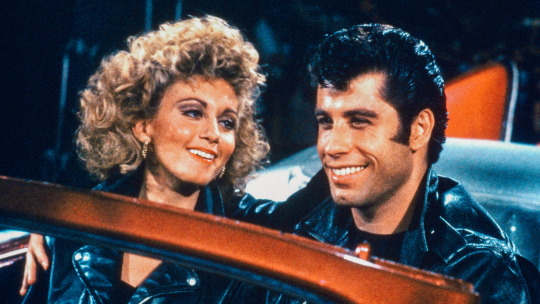
Olivia Newton-John and John Travolta in ‘Grease’ (1978).
What is the sexiest film you’ve ever seen?
When I was super young, it was definitely Grease, with Olivia Newton-John, when she was in her catsuit at the very end of it. I had her picture on my bedroom, above my bed sideways because I was only like ten years old or something. I was so in love with Olivia Newton-John. It wasn’t the film per se, it was her. Yeah, I find, personally, movies from the ’70s to be more sexy, but it has something to do with the super-loose way that people were dressed and people were behaving.
And the other one was later in life: Basic Instinct. Sharon Stone. I’m not talking about like the famous shot, right, where she crosses her legs. I’m not talking about that, but the way that she acts throughout the whole movie. It’s insane. It’s really great.
Are there any films that have scared you? Like, truly terrified you?
Yeah, I’m not a big fan because I get sucked up too much in it. The found [footage] horror movies like Paranormal Activity and things like the Japanese version of The Grudge, I cannot watch that stuff. That gets me too much. Because when I watch a film, I cannot watch it with one eye half open, the other one closed, like, ‘Okay, kind of cool, interesting’. I just get sucked into it.
Is there a film that has made you cry like no other?
Oh yeah. Multiple. Once Upon a Time in America. The Godfather. Hable con Ella (Talk to Her). Betty Blue.

Thomas Holkenborg, AKA Junkie XL.
These are the films that make you weep?
Not like on a regular basis, but I remember those were the ones that I really got hit. I’m talking particularly about the third Godfather. That whole end scene when they get out of the church and then… It’s really well-acted. So many Godfather fans that were dismissive of the film when it came out, in retrospect, ten, fifteen, 20 years later, are like, ‘it’s a really good film’. And I actually think so.
Final question. Is there a film from the past year that you would recommend, that you’ve loved?
[Long pause.] The thing is that I watch pretty much a movie a day. So, that’s like three to four hundred movies. It [has] happened so often that I watch a film and then I’m just like an hour and 45 minutes in, it’s like, ‘wait, fuck, I’ve seen this thing before’.
So, we have an app for that…
[Laughs.]
Related content
Junkie XL’s Letterboxd Life in Film list
Freddie Baker’s review of Justice League
Dutch Cinema: Danielle’s extensive list of more than 2,000 films
Letterboxd Showdown: The Perfect Score (best film scores)
The official Junkie XL Reverb Shop
Follow Gemma on Letterboxd
#godzilla vs kong#justice league#zack snyder#zack snyder's justice league#batman#superman#aquaman#cyborg#the flash#godzilla#gojira#king kong#kong#blockbuster#composer#film composer#tom holkenborg#thomas holkenborg#junkie xl#synth#synth music#synthesizer#bass drum#mad max fury road#george miller#hans zimmer#letterboxd
6 notes
·
View notes
Photo

Best of Sundance 2021.
From pandemic-era stories, via portraits of grief, to the serendipitous 1969 trilogy, the Letterboxd crew recaps our favorite films from the first major festival of the year.
Sundance heralds a new season of storytelling, with insights into what’s concerning filmmakers at present, and what artistic innovations may be on the horizon. As with every film festival, there were spooky coincidences and intersecting themes, whether it was a proliferation of pandemic-era stories, or extraordinary portraits of women working through grief (Land, Hive, The World to Come), or the incredible serendipity of the festival’s ‘1969 trilogy’, covering pivotal moments in Black American history: Summer of Soul (...Or When the Revolution Could Not Be Televised), Judas and the Black Messiah and the joyful Street Gang: How We Got to Sesame Street.
The hybrid model of this year’s Sundance meant more film lovers across the United States—a record number of you, in fact—‘attended’ the prestigious indie showcase. Our Festiville team (Gemma Gracewood, Aaron Yap, Ella Kemp, Selome Hailu, Jack Moulton and Dominic Corry) scanned your Letterboxd reviews and compared them with our notes to arrive at these seventeen feature-length documentary and narrative picks from Sundance 2021. There are plenty more we enjoyed, but these are the films we can’t stop thinking about.
Documentary features

Summer of Soul (...Or, When the Revolution Could Not Be Televised)
Directed by Ahmir-Khalib Thompson (AKA Questlove)
One hot summer five decades ago, there was a free concert series at a park in Harlem. It was huge, and it was lovely, and then it was forgotten. The Harlem Cultural Festival of 1969 brought together some of the world’s most beloved Black artists to connect with Black audiences. The star power and the size of the crowds alone should have been enough to immortalize the event à la Woodstock—which happened the same summer, the film emphasizes. But no one cared to buy up the footage until Ahmir-Khalib Thompson, better known as Questlove, came along.
It would have been easy to oversimplify such a rich archive by stringing together the performances, seeking out some talking heads, and calling it a day. But Questlove was both careful and ebullient in his approach. “Summer of Soul is a monumental concert documentary and a fantastic piece of reclaimed archived footage. There is perhaps no one better suited to curate this essential footage than Questlove, whose expertise and passion for the music shines through,” writes Matthew on Letterboxd. The film is inventive with its use of present interviews, bringing in both artists and attendees not just to speak on their experiences, but to react to and relive the footage. The director reaches past the festival itself, providing thorough social context that takes in the moon landing, the assassinations of Black political figures, and more. By overlapping different styles of documentary filmmaking, Questlove’s directorial debut embraces the breadth and simultaneity of Black resilience and joy. A deserving winner of both the Grand Jury and Audience awards (and many of our unofficial Letterboxd awards). —SH
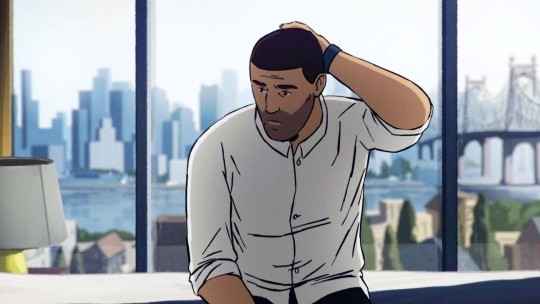
Flee
Directed by Jonas Poher Rasmussen
Flee is the type of discovery Sundance is designed for. Danish documentarian Jonas Poher Rasmussen tells the poignant story of his close friend and former classmate (using the pseudonym ‘Amin Nawabi’) and his daring escape from persecution in 1990s Afghanistan. Rasmussen always approaches tender topics with sensitivity and takes further steps to protect his friend’s identity by illustrating the film almost entirely in immersive animation, following in the footsteps of Waltz With Bashir and Tower. It’s a film aware of its subjectivity, allowing the animated scenes to alternate between the playful joy of nostalgia and the mournful pain of an unforgettable memory. However, these are intercepted by dramatic archive footage that oppressively brings the reality home.
“Remarkably singular, yet that is what makes it so universal,” writes Paul. “So many ugly truths about the immigration experience—the impossible choices forced upon people, and the inability to really be able to explain all of it to people in your new life… You can hear the longing in his voice, the fear in his whisper. Some don’t get the easy path.” Winner of the World Cinema (Documentary) Grand Jury Prize and quickly acquired by Neon, Flee is guaranteed to be a film you’ll hear a lot about for the rest of 2021. —JM

Taming the Garden
Directed by Salomé Jashi
There’s always a moment at a film festival when fatigue sets in, when the empathy machine overwhelms, and when I hit that moment in 2021, I took the advice of filmmaker and Sundance veteran Jim Cummings, who told us: “If you’re ever stressed or tired, watch a documentary to reset yourself.” Taming the Garden wasn’t initially on my hit-list, but it’s one of those moments when the ‘close your eyes and point at a random title’ trick paid off. Documentary director Salomé Jashi does the Lorax’s work, documenting the impact and grief caused by billionaire former Georgian PM Bidzina Ivanishvili’s obsession with collecting ancient trees for his private arboretum.
“A movie that is strangely both infuriating and relaxing” writes Todd, of the long, locked-off wide shots showing the intense process of removing large, old trees from their village homes. There’s no narration, instead Jashi eavesdrops on locals as they gossip about Ivanishvili, argue about whether the money is worth it, and a feisty, irritated 90-year-old warns of the impending environmental fallout. “What you get out of it is absolutely proportional to what you put into it,” writes David, who recommends this film get the IMAX treatment. It’s arboriculture as ASMR, the timeline cleanse my Sundance needed. The extraordinary images of treasured trees being barged across the sea will become iconic. —GG

The Most Beautiful Boy in the World
Directed by Kristian Petri and Kristina Lindström
Where Taming the Garden succeeds through pure observation, The Most Beautiful Boy in the World relies on the complete participation of its title subject, actor Björn Andrésen, who was thrust into the spotlight as a teenager. Cast by Italian director Lucino Visconti in Death in Venice, a 1971 adaptation of Thomas Mann’s novella about obsession and fatal longing, Andrésen spent the 1970s as an object of lust, with a side-gig as a blonde pop star in Japan, inspiring many manga artists along the way.
As we know by now (Alex Winter’s Showbiz Kids is a handy companion to this film), young stardom comes at a price, one that Andrésen was not well-placed to pay even before his fateful audition for Visconti. But he’s still alive, still acting (he’s Dan in Midsommar), and ready to face the mysteries of his past. Like Benjamin Ree’s excellent The Painter and the Thief from last year, this documentary is a constantly unfolding detective story, notable for great archive footage, and a deep kindness towards its reticent yet wide-open subject. —GG

All Light, Everywhere
Directed by Theo Anthony
Threading the blind spots between Étienne-Jules Marey’s 19th-century “photographic rifle”, camera-carrying war pigeons and Axon’s body-cam tech, Theo Anthony’s inquisitive, mind-expanding doc about the false promise of the all-seeing eye is absorbing, scary, urgent. It’s the greatest Minority Report origin story you didn’t know you needed.
Augmented by Dan Deacon’s electronic soundscapes and Keaver Brenai’s lullingly robotic narration, All Light, Everywhere proves to be a captivating, intricately balanced experience that Harris describes as “one part Adam Curtis-esque cine-essay”, “one part structural experiment in the vein of Koyaanisqatsi” and “one part accidental character study of two of the most familiar yet strikingly unique evil, conservative capitalists…”. Yes, there’s a tremendous amount to download, but Anthony’s expert weaving, as AC writes, “make its numerous subjects burst with clarity and profundity.” For curious cinephiles, the oldest movie on Letterboxd, Jules Jenssen’s Passage de Vénus (1874), makes a cameo. —AY
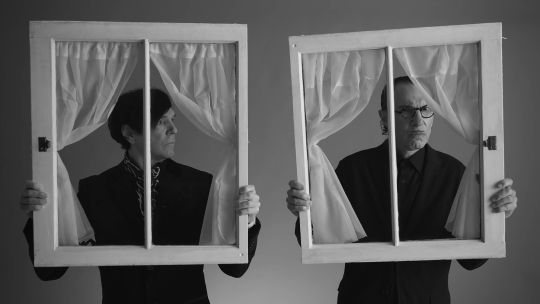
The Sparks Brothers
Directed by Edgar Wright
Conceived at a Sparks gig in 2017 upon the encouragement of fellow writer-director Phil Lord, Edgar Wright broke his streak of riotous comedies with his first (of many, we hope) rockumentary. While somewhat overstuffed—this is, after all, his longest film by nearly fifteen minutes—The Sparks Brothers speaks only to Wright’s unrestrained passion for his art-pop Gods, exploring all the nooks and crannies of Sparks’ sprawling career, with unprecedented access to brothers and bandmates Ron and Russell Mael.
Nobody else can quite pin them down, so Wright dedicates his time to put every pin in them while he can, building a mythology and breaking it down, while coloring the film with irresistible dives into film history, whimsically animated anecdotes and cheeky captions. “Sparks rules. Edgar Wright rules. There’s no way this wasn’t going to rule”, proclaims Nick, “every Sparks song is its own world, with characters, rules, jokes and layers of narrative irony. What a lovely ode to a creative partnership that was founded on sticking to one’s artistic guns, no matter what may have been fashionable at the time.” —JM
Narrative features

The Pink Cloud
Written and directed by Iuli Gerbase
The Pink Cloud is disorienting and full of déjà vu. Brazilian writer-director Iuli Gerbase constructs characters that are damned to have to settle when it comes to human connection. Giovana and Yago’s pleasant one-night stand lasts longer than expected when the titular pink cloud emerges from the sky, full of a mysterious and deadly gas that forces everyone to stay locked where they stand. Sound familiar? Reserve your groans—The Pink Cloud wasn’t churned out to figure out “what it all means” before the pandemic is even over. Gerbase wrote and shot the film prior to the discovery of Covid-19.
It’s “striking in its ability to prophesize a pandemic and a feeling unknown at the time of its conception. What was once science fiction hits so close now,” writes Sam. As uncanny as the quarantine narrative feels, what’s truly harrowing is how well the film predicts and understands interiorities that the pandemic later exacerbated. Above all, Giovana is a woman with unmet needs. She is a good partner, good mother and good person even when she doesn’t want to be. Even those who love her cannot see how their expectations strip her of her personhood, and the film dares to ask what escape there might be when love itself leaves you lonely. —SH

Together Together
Written and directed by Nikole Beckwith
Every festival needs at least one indie relationship dramedy, and Together Together filled that role at Sundance 2021 with a healthy degree of subversion. It follows rom-com structure while ostensibly avoiding romance, instead focusing on how cultivating adult friendships can be just hard, if not harder.
Writer-director Nikole Beckwith warmly examines the limits of the platonic, and Patti Harrison and Ed Helms are brilliantly cast as the not-couple: a single soon-to-be father and the surrogate carrying his child. They poke at each other’s boundaries with a subtle desperation to know what makes a friendship appropriate or real. As Jacob writes: “It’s cute and serious, charming without being quirky. It’s a movie that deals with the struggle of being alone in this world, but offers a shimmer of hope that even if you don’t fall in fantastical, romantic, Hollywood love… there are people out there for you.” —SH
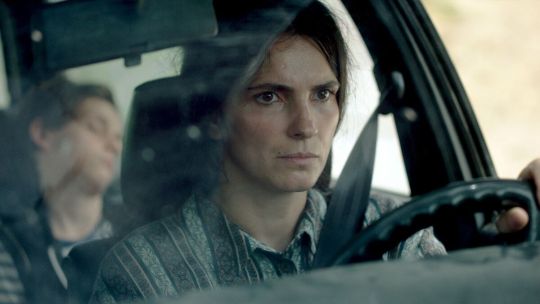
Hive
Written and directed by Blerta Basholli
Hive, for some, may fall into the “nothing much happens” slice-of-life genre, but Blerta Basholli’s directorial debut holds an ocean of pain in its small tale, asking us to consider the heavy lifting that women must always do in the aftermath of war. As Liz writes, “Hive is not just a story about grief and trauma in a patriarchy-dominated culture, but of perseverance and the bonds created by the survivors who must begin to consider the future without their husbands.”
Yllka Gashi is an understated hero as Fahrjie, a mother-of-two who sets about organizing work for the women of her village, while awaiting news of her missing husband—one of thousands unaccounted for, years after the Kosovo War has ended. The townsmen have many opinions about how women should and shouldn’t mourn, work, socialize, parent, drive cars and, basically, get on with living, but Fahrjie persists, and Basholli sticks close with an unfussy, tender eye. “It felt like I was a fly on the wall, witnessing something that was actually happening,” writes Arthur. Just as in Robin Wright’s Land and Mona Fastvold’s The World to Come, Hive pays off in the rare, beaming smile of its protagonist. —GG
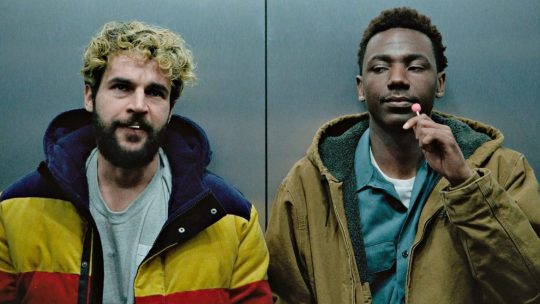
On the Count of Three
Directed by Jerrod Carmichael, written by Ari Katcher and Ryan Welch
It starts with an image: two best friends pointing guns at each other’s heads. There’s no anger, there’s no hatred—this is an act of merciful brotherly love. How do you have a bleak, gun-totin’ buddy-comedy in 2021 and be critically embraced without contradicting your gun-control retweets or appearing as though your film is the dying embers of Tarantino-tinged student films?
Comedian Jerrod Carmichael’s acerbic directorial debut On the Count of Three achieves this by calling it out every step of the way. Guns are a tool to give insecure men the illusion of power. They are indeed a tool too terrifying to trust in the hands of untrained citizens. Carmichael also stars, alongside Christopher Abbott, who has never been more hilarious or more tragic, bringing pathos to a cathartic rendition of Papa Roach’s ‘Last Resort’. Above all, Carmichael and Abbott’s shared struggle and bond communicates the millennial malaise: how can you save others if you can’t save yourself? “Here’s what it boils down to: life is fucking hard”, Laura sums up, “and sometimes the most we can hope for is to have a best friend who loves you [and] to be a best friend who loves. It doesn’t make life any easier, but it sure helps.” Sundance 2021 is one for the books when it comes to documentaries, but On the Count of Three stands out in the fiction lineup this year. —JM
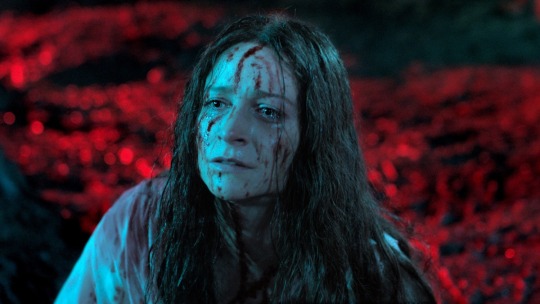
Censor
Directed by Prano Bailey-Bond, written by Bailey-Bond and Anthony Fletcher
The first of several upcoming films inspired by the ‘video nasty’ moral panic over gory horror in mid-’80s Britain, Prano Bailey-Bond leans heavily into both the period and the genre in telling the story of a film censor (a phenomenal Niamh Algar—vulnerable and steely at the same time) who begins to suspect a banned movie may hold the key to her sister’s childhood disappearance. Often dreamlike, occasionally phantasmagorical and repeatedly traumatic, even if the worst gore presented (as seen in the impressively authentic fictional horrors being appraised) appears via a screen, providing a welcome degree of separation.
Nevertheless, Censor is definitely not for the faint of heart, but old-school horror aficionados will squeal with delight at the aesthetic commitment. “I’m so ecstatic that horror is in the hands of immensely talented women going absolutely batshit in front of and behind the camera.” writes Erik. (Same here!) “A great ode to the video-nasty era and paying tribute to the great horror auteurs of the ’80s such as Argento, De Palma and Cronenberg while also doing something new with the genre. Loved this!” writes John, effectively encapsulating Censor’s unfettered film-nerd appeal. —DC

CODA
Written and directed by Siân Heder
A film so earnest it shouldn’t work, with a heart so big it should surely not fit the size of the screen, CODA broke records (the first US dramatic film in Sundance history to win all three top prizes; the 25-million-dollar sale to Apple Studios), and won the world over like no other film. “A unique take on something we’ve seen so much,” writes Amanda, nailing the special appeal of Siân Heder’s coming-of-ager and family portrait. Emilia Jones plays Ruby, the only hearing person in her deaf family, at war between the family business and her passion for singing. While Heder is technically remaking the French film La Famille Bélier, the decision to cast brilliant deaf actors—Troy Kotsur, Marlee Matlin and Daniel Durant—makes this feel brand new.
But it’s not just about representation for the sake of it. A sense of authenticity, in humor as much as affection, shines through. With a script that’s 40 per cent ASL, so many of the jokes are visual gags, poking fun at Tinder and rap music, but a lot of the film’s most poignant moments are silent as well. And in Ruby’s own world, too, choir kids will feel seen. “I approve of this very specific alto representation and the brilliant casting of the entire choir,” Laura confirms in her review. Come for the fearless, empathetic family portrait, stay for the High School Musical vibes that actually ring true. —EK
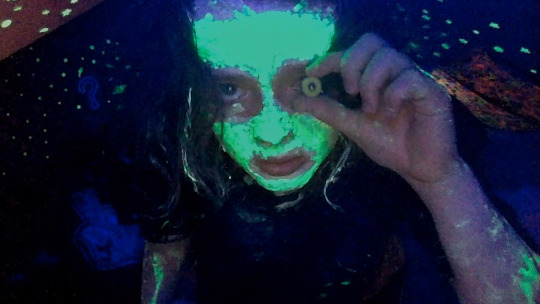
We’re All Going to the World’s Fair
Written and directed by Jane Schoenbrun
Perhaps the most singular addition to the recent flurry of Extremely Online cinema—Searching, Spree, Host, et al—Jane Schoenbrun’s feature debut ushers the viewer into a haunted, hypno-drone miasma of delirium-inducing YouTube time-suck, tenebrous creepypasta lore and painfully intimate webcam confessionals. Featuring an extraordinarily unaffected, fearless performance by newcomer Anna Cobb, the film “unpacks the mythology of adolescence in a way that’s so harrowingly familiar and also so otherworldly”, writes Kristen. Not since Kiyoshi Kurosawa’s Pulse has there been such an eerily lonely, and at times strangely beautiful, evocation of the liminal spaces between virtual and real worlds.
For members of the trans community, it’s also a work that translates that experience to screen with uncommon authenticity. “What Schoenbrun has accomplished with the form of We’re All Going to the World’s Fair is akin to catching a wisp of smoke,” writes Willow, “because the images, mood and aesthetic that they have brought to life is one that is understood completely by trans people as one of familiarity, without also plunging into the obvious melodrama, or liberal back-patting that is usually associated with ‘good’ direct representation.” One of the most original, compelling new voices to emerge from Sundance this year. —AY
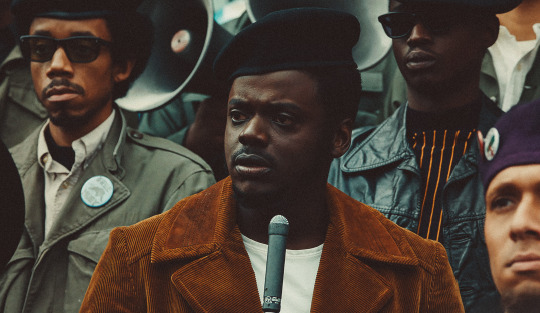
Judas and the Black Messiah
Directed by Shaka King, written by King, Will Berson, Kenneth Lucas and Keith Lucas
It was always going to take a visionary, uncompromising filmmaker to bring the story of Fred Hampton, the deputy chairman of the national Black Panther Party, to life. Shaka King casts Daniel Kaluuya as Hampton, and LaKeith Stanfield as William “Wild Bill” O’Neal, the FBI informant whose betrayal leads to Hampton’s assassination. Both actors have never been better, particularly Kaluuya who Fran Hoepfner calls “entrancing, magnetic, fizzling, romantic, riveting, endlessly watchable.”
Judas and the Black Messiah is an electric, involving watch: not just replaying history by following a certain biopic template. Instead, it’s a film with something to say—on power, on fear, on war and on freedom. “Shaka King’s name better reverberate through the halls of every studio after this,” writes Demi. A talent like this, capable of framing such a revolution, doesn’t come around so often. We’d better listen up. —EK

Pleasure
Directed by Ninja Thyberg, written by Thyberg and Peter Modestij
A24’s first purchase of 2021. Ironically titled on multiple levels, Pleasure is a brutal film that you endure more than enjoy. But one thing you can’t do is forget it. Ninja Thyberg’s debut feature follows a young Swedish woman (Sofia Kappel) who arrives in Los Angeles with dreams of porn stardom under the name ‘Bella Cherry’. Although Bella is clear-eyed about the business she’s getting into, Thyberg doesn’t shy away from any of the awfulness she faces in order to succeed in an industry rife with exploitation and abuse. Bella does make allies, and the film isn’t suggesting that porn is only stocked with villains, but the ultimate cost is clear, even if it ends on an ever-so-slightly ambiguous note.
Touching as it does on ambition, friendship and betrayal in the sex business, Pleasure is often oddly reminiscent of Paul Verhoeven’s Showgirls. Or rather, the gritty film Showgirls was claiming to be, as opposed to the camp classic it became. There’s nothing campy here. Kappel is raw and fearless in the lead, but never lets the viewer lose touch with her humanity. Emma puts it well: “Kappel gives the hardest, most provocative and transfixing performance I’ve seen all festival.” “My whole body was physically tense during this,” writes Gillian, while Keegan perhaps speaks for most when she says “Great film, never want to see it again.” —DC
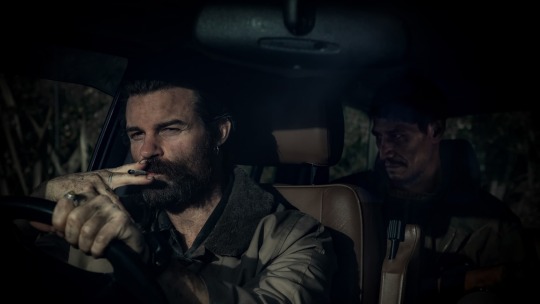
Coming Home in the Dark
Directed by James Ashcroft, written by Ashcroft and Eli Kent
A family camping trip amidst some typically stunnin—and casually foreboding— New Zealand scenery is upended by a shocking rug-pull of violence that gives way to sustained terror represented by Daniel Gillies’ disturbingly calm psychopath. The set-up of this thriller initially suggests a spin on the backwoods brutality thriller, but as Coming Home in the Dark progresses and hope dissipates, the motivations reveal themselves to be much more personal in nature, and informed on a thematic level by New Zealand’s colonial crimes against its Indigenous population. It’s a stark and haunting film that remains disorientating and unpredictable throughout, repeatedly daring the viewer to anticipate what will happen next, only to casually stomp on each glimmer of a positive outcome.
It’s so captivatingly bleak that a viewing of it, as Collins Ezeanyim’s eloquent reaction points out, does not lend itself to completing domestic tasks. The film marks an auspicious debut for director and co-writer James Ashcroft. Jacob writes that he “will probably follow James Ashcroft’s career to the gates of Hell after this one”. Justin hits the nail on the head with his description: “Lean and exceptionally brutal road/revenge film … that trades in genre tropes, especially those of Ozploitation and ’70s Italian exploitation, but contextualizes them in the dark history of its country of origin.” —DC
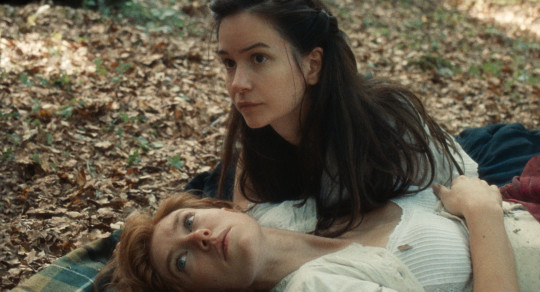
The World to Come
Directed by Mona Fastvold, written by Ron Hansen and Jim Shepard
Mona Fastvold has not made the first, nor probably the last, period romance about forbidden lesbian love. But The World to Come focuses on a specific pocket in time, a world contained in Jim Shepard’s short story ‘Love & Hydrogen’ from within the collection giving the film its name. Katherine Waterston and Vanessa Kirby are Abigail and Tallie, farming neighbors, stifled by their husbands, who find brief moments of solace, of astonishment and joy, together. What shines here is the script, a verbose, delicate narration that emanates beauty more than pretence. “So beautifully restrained and yet I felt everything,” Iana writes.
And you can feel the fluidity and elegance in the way the film sounds, too: composer Daniel Blumberg’s clarinet theme converses with the dialogue and tells you when your heart can break, when you must pause, when the end is near. “So much heartache. So much hunger. So much longing. Waves of love and grief and love and grief,” writes Claira, capturing the ebb and flow of emotion that keeps The World to Come in your mind long after the screen has gone silent. —EK
Related content
The 2021 Sundance Film Festival lineup by Letterboxd rating
Letterboxd’s ‘Official’ Top 50 of 2021
Awards Season 2020-2021: our awards-tracker list
Letterboxd’s Festiville HQ: our home for up-to-the-minute festival coverage
#sundance#sundance film festival#sundance 2021#sundance2021#questlove#summer of soul#black woodstock#shaka king#judas and the black messiah#letterboxd top 50#best of sundance 2021#letterboxd
11 notes
·
View notes
Text
my cousin rachel review redacted in the fear of letterboxd editor in chief gemma gracewood giving my profile a cursory glance when considering the pitches
2 notes
·
View notes
Photo

2020 Needle Drops.
The Letterboxd crew celebrates the best bangers in 2020 films, from Birds of Prey to David Byrne’s American Utopia.
Every year is a good year for music in movies but, for some reason, 2020’s music cues have stuck with us a bit harder than usual. Gemma Gracewood, Ella Kemp, Jack Moulton and Aaron Yap interrupt their holidays to compile a Letterboxd Spotify playlist of their favorite needle drops of the past year. The conversation below contains mild spoilers.
GG: First off, how do we define a ‘needle drop’? Do we need to define a needle drop? Isn’t it obvious?
EK: I feel like it’s a definition that we can spin so many different ways.
GG: There are iconic soundtracks, and then there are specific music moments in movies, where the film itself isn’t necessarily filled with wall-to-wall bangers à la Pulp Fiction or Trainspotting. Needle drops can happen in both. Ella, I enjoyed your description in your 50 favorite music cues piece for The Quietus: “There are fewer pleasures greater, at the movies, than the moment a perfect track starts at a perfect moment, and the marriage of music and film creates an entirely new beast, a work of art in that new connection alone.” It reminds me of Ekwa Msangi’s view, in her recent Letterboxd interview, that music is “the third language” in film.
EK: Perhaps the most vivid 2020 example would be in the masterpiece that is Eurovision Song Contest: The Story of Fire Saga, bursting at the seams with songs and needle drops. ‘Ja Ja Ding Dong’ is one of many original songs that do the job very well, but ‘Song-A-Long’ is the only real needle drop: a record-scratch moment where something you thought you knew appears in a new context, and the marriage is perfect.
GG: With Eurovision in mind, then, what are the rules here? How many bangers is a film allowed to have in our playlist? How will we choose between ‘Silly Games’ and ‘Kung Fu Fighting’ for Lovers Rock?!
EK: In a normal year I would say one banger per film, but considering that 1) so many films were snatched from our clutches this year 2) the films that were released were unusually generous in terms of just how many bangers we were given, I would say that anything goes.
JM: I’m highly in favor of Lovers Rock getting the one exception here.
EK: Well, yes, but, then… Palm Springs will fight about it.
AY: A vote in favor of throwing rules out of the window—we’ve had enough rules this year.
GG: With those very loose parameters agreed on, let’s launch into it. Who wants to start at the beginning, all the way back when cinema’s main problem was the original title of Birds of Prey?
EK: Remember seeing movies on the big screen? I saw—draws breath—Birds of Prey (and the Fantabulous Emancipation of One Harley Quinn) in the cinema and was so wonderfully entertained and charmed by all of it. Yes, it’s flashy and violent and energetic and all those good things but it’s also loud, and is very clever with its volume. A personal standout moment is Jurnee Smollett-Bell fully arriving as Black Canary as she sings ‘It’s A Man’s Man’s Man’s World’. Obviously the meanings couldn’t be more on the nose, but the fact that Smollett-Bell’s voice is so elegant and powerful, perfect for a character whose greatest weapon is her voice, just elevates this way beyond any easy wink to camera about how the women are in charge now. There’s just no denying the beauty and power in this musical moment.

Jurnee Smollett-Bell as Black Canary in ‘Birds of Prey’.
GG: If we’re talking on-the-nose lyrics that work spectacularly well, I still haven’t recovered from the two music cues performed by Sidney Flanigan in Never Rarely Sometimes Always. There’s the ‘He’s Got the Power’ opening song, which sees Flanigan’s Autumn alone on her high-school stage, acoustic guitar, glitter, pearls, a Pink Ladies-inspired jacket, performing an edgy cover, near the top of her vocal range, of a usually upbeat doo-wop tune about a guy who makes her do things she doesn’t wanna do, but she adores him anyway. (Watching on is Sharon Van Etten as Autumn’s mother, adding extra grit if you’re a fan, which I am.)
Later, much later, after the much-written-about “never, rarely, sometimes, always” scene, Autumn and her cousin Skylar hit a Midtown karaoke bar while killing time before their bus home from New York City. In a much more comfortable register, Autumn confidently nails another 1960s hit, Gerry and the Pacemakers’ ‘Don’t Let the Sun Catch You Crying’, while Skylar works on earning their bus fare home. There’s so much going on in a scene that really consists of just two or three shots. The lyrics are superlatively spot-on, and I truly do hope that 2021 will bring joy for every girl and boy.

Sidney Flanigan as Autumn in ‘Never Rarely Sometimes Always’.
JM: Since we’re talking about needle drops that are performed by movie characters, can I talk about the build-up to the big needle drop in the finale of One Night in Miami? Leslie Odom Jr.’s Sam Cooke is treated as entertainer first, artist second, with Kingsley Ben-Adir’s Malcolm X spending much of their shared screen time encouraging Cooke to use his platform—one popular among whites—for the greater good. When Cooke finally delivers ‘A Change is Gonna Come’ on The Tonight Show, thus defining his career from that point forward, the impact is tenfold and the film finds its magic in the nick of time.
If Odom Jr. is a future Best Supporting Actor winner, this scene will go down as his showcase (and ultimately free of the goodwill from Hamilton’s afterglow). Yes, a civil change did come in the years after the song’s 1964 debut, but we obviously still have a long way to go. And yet, there’s something reflective in the way this moment is about the responsibility of powerful Black voices, and how this idea is executed by director Regina King is profound. It definitely hints without much subtlety that One Night in Miami is but a whisper of what’s to come from her in terms of using her own platform to encourage others to further spread the message. It’s possibly the year’s most important and historic needle drop.
GG: Obviously we need to talk about Steve McQueen’s Small Axe collection, specifically Lovers Rock—a film that’s all about literal needle drops.
JM: ‘Kung Fu Fighting’, I think, is the most essential needle drop in the film because the song, even if nostalgic, has become such a novelty tune, but within seconds McQueen brings back the fresh and exciting communal atmosphere that song creates and is famous for. And it is a subversive moment, because we anticipate Lovers Rock to be comprised primarily of the deep cuts that were coming fresh from Jamaica at the time—but then they drop this one-hit-wonder disco banger that we used to listen to all the time as kids, so it has this sardonic playful tone that’s just pure, non-judgmental joy. It cuts through the tension bubbling outside the house with immediate mock fighting, everyone free to show off their best moves without a sincere threat. You’re already in the door, but the moment the song starts is the film’s true invitation to party down and let loose.
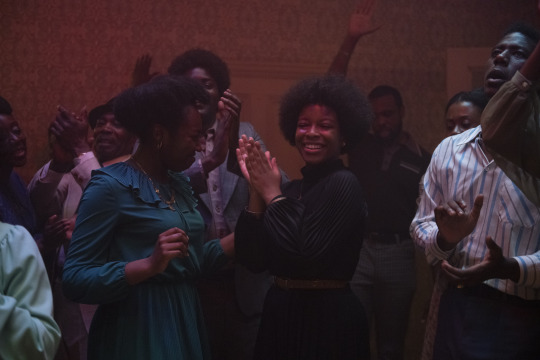
On the ‘Lovers Rock’ dance-floor.
GG: And then there’s the a-cappella singalong to Janet Kay’s ‘Silly Games’—
JM: —which is foreshadowed with the women singing it while they cook during the party prep.
GG: When that sublime scene happens, it’s a glorious feeling as a viewer—not only because house parties are currently dangerous to our health, but also because we’re witnessing a film’s cast and crew give everything over to this improvised moment, and they’re able to do so because they have created the perfect conditions to let it happen. I adore watching a crew that’s in the zone. What is the opposite of a ‘drop’? Is there a term for the euphoric romanticism that these slower dance-floor moments create? Peaking, I guess? In this scene, I also recognized a thread that runs all the way back to Cassandra’s ‘Thank You For the Many Things You Have Done’ in the 1980 film Babylon, another music-soaked movie about West-Indian Londoners. And, in a way, the ‘Too Late to Turn Back Now’ dance-floor magic in BlacKkKlansman. (Which reminds me to shout out Spike Lee, the OG needle-drop king, who represented this year with a pair of Marvin Gaye tunes in Da 5 Bloods.)
AY: Sadly I have yet to experience that Lovers Rock euphoria, but would consider the two big drops in Thomas Vinterberg’s Another Round closest to the feeling than any other movie I’ve seen this year. Danish pop outfit Scarlet Pleasure’s ‘What A Life’ sends the film off perfectly to an explosively cathartic and hopeful finish—aided in no small part by Mads’ glorious dancing. But I almost prefer the slinky way The Meters’ ‘Cissy Strut’ (literally a needle drop) shifts the film to its next level, ushering Mads and his teacher pals into one hot boozy mess of a night to (mis)remember. Bob my head I did.
GG: I want to shout out the folk whose job it is to craft a soundtrack that elevates a film. Music supervision is some kind of insane superpower. Supervisors need to know everything about music—not just what’s been, but what’s coming. They get clearance for the best songs, often on tiny budgets (weirdly, there’s no industry standard for the price of music in films, and the budget rides on some mysterious “favored nations” math), and it’s more often than not about relationships. They also make suggestions about who should cover a song, if they’re not using the original, and in doing so, they have the power to launch new artists with a perfect needle drop. They revive careers, and make stars of unknowns. In the upcoming documentary about the Dawn Raid music label, there’s an amazing story about the use of the song ‘Swing’ by Samoan-New Zealand hip-hop/EDM star Savage in Judd Apatow’s Knocked Up, which changed everything for Savage. It literally changed his life. Basically, somehow, music supervisors exist in the swirl of the zeitgeist, even though a film may be a year or two from release.
EK: Music supervisors have really pulled out all the stops this year. One of my favorite romantic scenes was seeing ‘Honey’ by Robyn pop up in Levan Akin’s gorgeous And Then We Danced—to which he credited music supervisor Jen Malone when we chatted about the film last year. What I loved was that the song really hadn’t come out that long ago, so it always feels particularly visceral and alive to me to recognize a song that, first of all, is incredible, but also so fresh in my mind that it feels like we very much exist in the same reality as these characters. Especially considering the boys in Akin’s film are exploring their sexuality and Robyn’s music has helped so many people come to terms with theirs, and the lyrics of her song are also felt in the golden light that colors the scene in the film. It’s such a special moment that you can tell comes from the very simple fact that everyone holds Robyn so close in their hearts, and you just know when it’s the right fit. I’m so glad it paid off.
AY: Also, a quick shout-out to Babyteeth for dropping Vashti Bunyan’s wistful ’70s folk gem ‘Diamond Day’—a song that seems like it should be overused in twee indie coming-of-age flicks, but as far as I’m aware, hasn’t quite got there yet.
JM: And to The Nest, for giving us the gift of Carrie Coon in a club letting it all go to Bronski Beat’s ‘Smalltown Boy’.
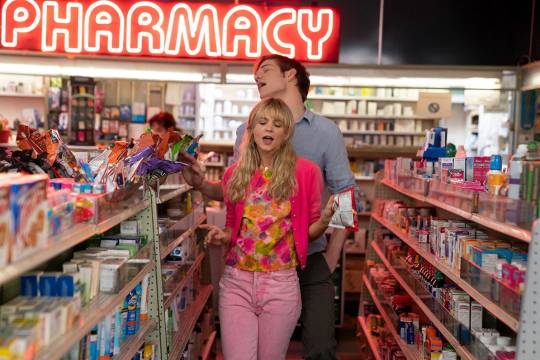
Promising young woman and man dance in a pharmacy.
EK: I feel like the best and most satisfying needle drop moments happen when you have no idea they’re coming—I had seen everyone talking about a Paris Hilton moment in Promising Young Woman but this scene still totally caught me off guard and I miss it whenever I’m not watching it. I can’t say I knew ‘Stars Are Blind’ off by heart beforehand, but I do now. Is it a banger in its own right? I honestly couldn’t say, as whenever I close my eyes I now see Carey Mulligan and Bo Burnham dancing around a pharmacy in shades of baby pink and blue while the most adorable romantic montage I’ve ever seen in my life plays through the honeymoon stage of their relationship. It’s so cheesy and everyone knows it, but it hits such a rare sweet-spot in being uncool, self-aware, glassy-eyed and rosy-cheeked without a dash of cynicism. It’s romantic and silly and so perfect—and for a film with so much bite, it feels like gold dust, a stroke of genius.
JM: There was one needle drop in 2020 that was 32 years in the making. It’s much less about how good the song is (it’s not very), but rather what this moment meant to a beloved franchise and its iconic characters. I’m talking about ‘Face the Music’ from Bill & Ted Face the Music. When Bill & Ted 3 was teased ten years ago, it became clear that their destiny had not been fulfilled in Bogus Journey’s coda. And so, in 2020, Bill and Ted are still hunting down the song that will save the Universe. Switching the mission from themselves to their daughters is a good way for original authors Chris Matheson and Ed Solomon to write around Bill and Ted’s goofy incompetence, and by adding contributions from the world’s greatest composers (Mozart, Kid Cudi, et al), they more than compensate for the imagination required to live up to the song’s grandiose promise. The climactic song (performed on my local freeway of all places!) is deliberately a mixed bag. It has to be—it’s the best-case scenario for too many cooks. But it’s the final ingredient, when Bill and Ted don their guitars at the last second—with a nod of approval from Jimi Hendrix—that delivers rock ’n’ roll’s promise to save the universe, ’80s style.
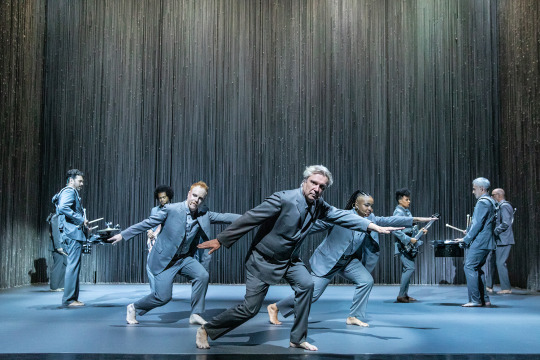
‘David Byrne’s American Utopia’.
GG: There are many more songs on our playlist that we could talk about, but since we’re supposed to be on holiday and this is a no-rules competition, can I finish by nominating David Byrne’s American Utopia as the overall 2020 winner for most best needle drops?
JM: You probably need to choose at least one song from that Broadway sensation to talk about.
GG: Fine, then it can only be the cover of Janelle Monáe’s ‘Hell You Talmabout’. Say their names.
The Best Needle Drops of 2020
Where the movie version is unavailable, we have included the original. Enjoy the full playlist on Spotify.
Charlie XCX—‘Boys’ (Promising Young Woman)
Paris Hilton—‘Stars Are Blind’ (Promising Young Woman)
The Weather Girls—‘It’s Raining Men’ (Promising Young Woman)
Bee Gees—‘Stayin Alive’ (Undine)
Janet Kay—‘Silly Games’ (Lovers Rock)
Carl Douglas—‘Kung Fu Fighting’ (Lovers Rock)
Toots & The Maytals—‘Pressure Drop’ (Mangrove)
Bronski Beat—‘Smalltown Boy’ (The Nest)
Gerry & The Pacemakers—‘Don’t Let the Sun Catch You Crying’ (Never Rarely Sometimes Always)
Patrick Cowley—‘Megatron Man’ (Palm Springs)
Kate Bush—‘Cloudbusting’ (Palm Springs)
Sam Cooke—‘A Change is Gonna Come’ (One Night in Miami)
Marvin Gaye—‘Got to Give It Up’ (Da 5 Bloods)
Marvin Gaye—‘What’s Going On’ (Da 5 Bloods)
Doja Cat—‘Boss Bitch’ (Birds of Prey)
Jurnee Smollett-Bell—‘It’s A Man’s Man’s Man’s World’ (Birds of Prey)
The The—‘This Is the Day’ (Love and Monsters)
Wyld Stallyns—‘Face The Music’ (Bill & Ted Face the Music)
Angel Olsen—‘Mr. Lonely’ (Kajillionaire)
Tears for Fears—‘Everybody Wants To Rule The World’ (Tesla)
Travis Scott—‘The Plan’ (Tenet)
Cast—‘Song-A-Long’ (Eurovision Song Contest: The Story of Fire Saga)
Dido—‘White Flag’ (Bad Education)
Aurora—‘Running with the Wolves’ (Wolfwalkers)
Bonga—‘Mona Ki Ngi Xica’ (Farewell Amor)
Moby—‘In This World’ (Bad Education)
Robyn—‘Honey’ (And Then We Danced)
Pet Shop Boys—‘Always on My Mind’ (Matthias et Maxime)
Kid Cudi—‘Pursuit of Happiness’ (The King of Staten Island)
The Meters—‘Cissy Strut’ (Another Round)
Scarlet Pleasure—‘What a Life’ (Another Round)
Vashti Bunyan—‘Just Another Diamond Day’ (Babyteeth)
Janelle Monáe—“Hell You Talmabout” (David Byrne’s American Utopia)
Aretha Franklin—‘(You Make Me Feel Like) A Natural Woman’ (I’m Your Woman)
Related content
Letterboxd members nominate their favorite film needle drops of 2020
The Letterboxd Showdown of best film soundtracks
Follow Gemma, Ella, Jack and Aaron on Letterboxd
#letterboxd#letterboxd crew#needle drop#needle drops#music cues#music cues in movies#soundtrack#film soundtrack#2020 best of#2020 films#birds of prey#never rarely sometimes always#spike lee#small axe#steve mcqueen#promising young woman#sharon van etten
6 notes
·
View notes
Photo

Boxing On.
Chick Fight star and former competitive figure skater Malin Åkerman tells Gemma Gracewood about the meditative power of boxing, how Margot Robbie inspired her to become a producer, and her adoration for Tilda Swinton.
One of film’s earliest preserved specimens is The Gordon Sisters Boxing (1901), a 90-second curio in which sisters Bessie and Minnie Gordon go at it with boxing gloves, in full petticoats, in front of a genteel scene of a formal garden with fountain centerpiece. It’s theatrical yet strangely thrilling, possibly because women’s fight films are few and far between.
There’s 2004’s po-faced, Oscar-winning Million Dollar Baby, Priyanka Chopra’s 2014 turn as Indian boxing star Mary Kom, and last year’s Fighting with My Family, a good-time, must-see starring our girl Florence Pugh as a pro wrestler. But a global sports-fighting industry stacked with female champs hasn’t really translated into big screen chick-fights. The best woman-on-woman fight scenes are usually contained in narrative action (the airplane scrap between KiKi Layne and Charlize Theron in The Old Guard was one of 2020’s highlights on that front).
And that’s, in part, what attracted actor and emerging producer Malin Åkerman to Chick Fight, a story set around a secret underground women’s fight club founded by a therapist to give her patients a physical outlet for their rage. “I love boxing,” says Åkerman. “It’s not a man’s sport. It’s an everyman’s sport, it’s an everywoman’s sport. It’s a very cathartic experience for me because afterwards I feel like I’ve gotten everything out.”
Åkerman plays Anna, a 40-something financial and emotional disaster whose bestie introduces her to the club once she hits rock bottom. That friend, Charleen, is played winningly by comedian Dulcé Sloan, with a fun turn by Fortune Feimster as the fight club referee, plus Alec Baldwin as Anna’s booze-loving trainer, and former WWE star Kevin Nash as her recently out father.

Malin Åkerman and Alec Baldwin in ‘Chick Fight’.
Though she has has starred in more than 40 films, Åkerman is new to producing (Friendsgiving is her other film out this month). The hunt for projects she could take the lead on began after the jolt of missing out on a role uniquely suited to her: Tonya Harding in I, Tonya. “I grew up as a figure skater, I competed nationally in Canada for ten years,” Åkerman says, recalling that she hit up her team: “I just said, ‘How come I didn’t even get called in for this?’ And they said, ‘Well, because Margot Robbie built it from the ground up. She produced it.’ I went ‘aaah’ and a light bulb went up over me and I went, ‘Alright, that’s it, I just have to take things into my own hands and start finding material’.”
Chick Fight was scripted by first-time feature writer Joseph Downey, who strives to create female-led stories. Some aspects feel contrived—a rivalry between Anna and Bella Thorne’s Olivia in particular; Alec Baldwin in general—but Åkerman worked with director Paul Leyden, a good friend, to enhance “the female perspective and the female voice” in the script. This comes across in scenes between Anna and Charleen, which tingle with no-bullshit connection. “I think that the important message in this film was sisterhood. It’s so important to focus on the fact that women supporting women has so much power and strength. We need to stick together and we need to be this force of unity.”
In the pursuit of more projects, her lockdown has been a whirl of Zoom meetings with potential writers—a silver lining of the pandemic. “I’ve had time to focus on searching for new material. Just taking the bull by the horns and creating the material that [I] wanna create. That is the way to go.” Åkerman herself is partial to “films that breathe”, giving No Country for Old Men, Babel and Call Me by Your Name as examples. “I just think there is so much art involved in those types of films.” Javier Bardem and Tilda Swinton stand out in her “Rolodex of actors” as particular fascinations. “Anything Tilda does, I will watch.”
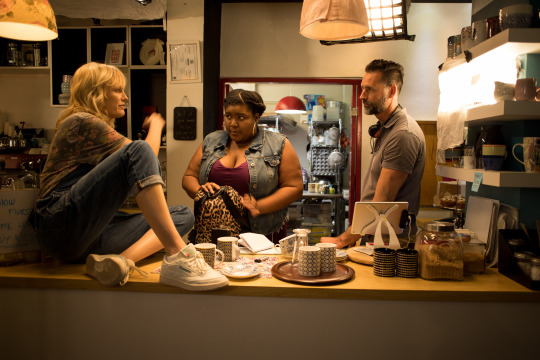
Malin Åkerman, Dulcé Sloan and director Paul Leyden on the set of ‘Chick Fight’.
Those films and artists, Åkerman readily adds, are “a long shot from the kinds of genres I usually get myself involved in”. Chick Fight, on the other hand, fits neatly in the Åkerman universe—a breezy comedy that balances silly training montages with meatier questions. While above ground, it looks like a classic comedy, the underground cage fights are filmed at high-speed to allow for the visceral, glossy slow-mo shots that come part-and-parcel with today’s movie fights—roundhouse kicks, fists meeting bones, spit and blood flying—and sound effects to match. “That guttural, animal instinct is so amazing to be able to release,” Åkerman enthuses.
It feels important to note, given the David Fincher elephant in the room, that Chick Fight’s only commonality with Fight Club is the three words “secret fight club”. Åkerman says the films that more directly influenced Chick Fight are Rocky (“this is the comedic version of that underdog story”), and the buddy-movie vibe of Thelma & Louise. “That’s the closest to this that we could get. It’s that ‘enough is enough’ feeling. I just love that film. It’s, like, ‘Fuck the system and fuck society as it’s been created and told us to be and not to be. Let’s break down those barriers’.”
The Thelma & Louise connection feels especially strong in Anna’s very sudden economic descent from small business owner to evicted, unemployed and dispossessed. It’s a clear-eyed statement, in the middle of a comedy, on the lack of a social safety net in America, particularly for women—and on the importance of finding your own community (and for many, choosing your own family).
Åkerman was born in Sweden and raised in Canada; both are countries with stronger systems in place for social support, and pro-women policies. “Everything seems a bit more logical over there.” On pandemic-ridden, post-election America, she says, “That's been really interesting, to take into account what kind of country we’re actually living in and what needs to be worked on. I hope that we continue to move forward and not backwards as far as women and equality goes.”
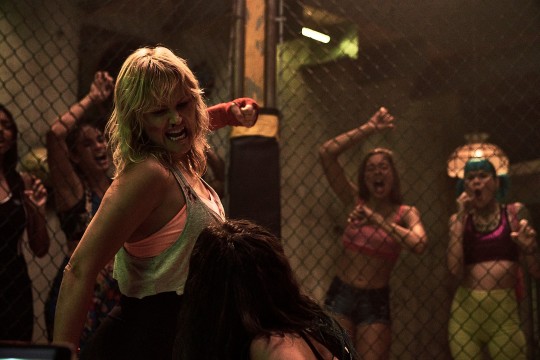
Among the many downsides of the coronavirus pandemic, one is the closure of gyms and sports clubs, an inconvenient side-effect at a time when exercise—an outlet for stress and frustration—is so beneficial for mental-health management. Which brings us back to the joy of boxing: “Most of us have so much on our minds; life is so full of anxiety, or stresses, and it’s so hard to shut that off.”
“Some people are able to shut up their brains by actually sitting and meditating. My brain just gets much louder when I do that, so if I am able to just concentrate on not getting hit in the face, I am completely out of my mind and in my body.”
Related content
Zoe Bell’s quarantine Boss Bitch Fight Challenge, featuring Scarlett Johansson, Halle Berry, Drew Barrymore, Lucy Lawless, Margot Robbie and more
Female Friendships in Film—a list by Vanina
Female Friendship by Female Directors—a list by Vee
Showdown: Fight Club—the best two-person duels in movie history
Follow Gemma on Letterboxd
‘Chick Fight’ is in theaters and on demand in the US now.
#chick fight#malin akerman#fight club#underground fight club#boxing#kickboxing#boxing film#alec baldwin#dulce sloan#fortune feimster#women make movies#letterboxd
6 notes
·
View notes
Photo
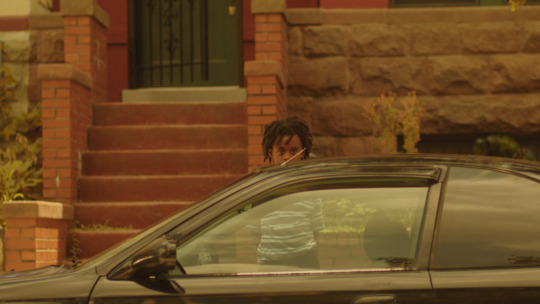
Green-Light Yourself.
As Merawi Gerima’s debut feature Residue lands on Netflix, he tells Gemma Gracewood about being the son of indie film legends, duty of care as a director, and why Akira is his go-to comfort movie.
Sometimes it’s impossible to move forward with your art until you’ve taken a good look back. In Merawi Gerima’s impressionistic and hypnotic first feature, Residue, a young man, Jay, returns from college on the West Coast to find that his Washington, DC neighborhood has been hugely transformed within a few short years. A white neighbor barks at him to turn his car stereo down. Familiar faces have disappeared. The gentrification is debilitating, but Jay’s efforts to work out his disorientation and rage through art meets opposition with old friends.
Like his lead character, Gerima is both a DC native and a graduate of a West Coast college (USC’s School of Cinematic Arts), and was similarly confronted by change when he got home. Making Residue was “absolutely something that I had to do because that was the only positive direction to pour my energies into,” he says. “I think that there was a lot of destructive potential in my life at that point. The film really was the first moment when I started to feel that I perhaps was not powerless in this situation.”
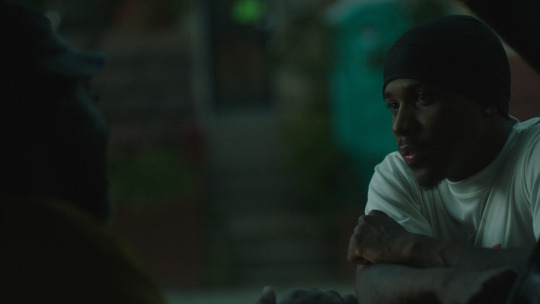
Derron “Rizzo” Scott as Mike in ‘Residue’.
Gentrification as a form of structural racism has long impacted Black communities, and Gerima is not the first in his family to cover this ground. His parents are the LA Rebellion filmmakers Haile Gerima, whose work includes the Golden Bear-nominated 1983 slavery drama Sankofa, and Shirikiana Aina, who documented changes to their DC neighborhood in her 1982 non-fiction short Brick by Brick.
Residue was a family affair; the Gerima name is all through the credits. “My aunts were the chefs; my sister, she was, like, the head of the catering.” Although his legendary father managed to get off lightly with Costco runs, Gerima’s equally impressive mother ended up anchoring two of the film’s most affecting scenes, as Tonya, the Mom of Jay’s childhood friend, Mike (Derron “Rizzo” Scott).
“I had somebody else cast—she was a no-show. My mother was on set that day, just kind of helping feed people. I knew that she had what we needed, emotionally speaking. She was actually trying to drive away to go find the woman; I was like, ‘Nah, I need you right now’. She did it, but at a great cost.” The thing about filming in your own neighborhood, Gerima explains, where you’ve raised not only your own but also everyone else’s kids, with varying outcomes, is you end up bringing that lived experience to your scenes. “It’s very real for her. She’s not acting. I almost cried once we finished filming. Nobody spoke for a long time.”
The scene taught Gerima much about a director’s duty of care—particularly when he dared to ask his mother for a second take of a pivotal scene that takes place in a downpour. “In preparing to shoot in the rain we made a few mistakes, with the camera, the placement, there was miscommunication with me and the DP [Mark Jeevaratnam]. I, he, we both agreed that we needed another take. When I asked my mother for another take, she just looked at us like, it hurt, it was painful to ask. She did what she could, but you could tell that she didn’t have it in her.” As it turns out, the first take was the one. “I thought we ruined everything, but once I slowed down, I just saw what a miracle it was.”
It’s impossible to separate Residue from its limited budget and circumstances. Structurally rich and technically unusual, the film is a triumph of local knowledge, happy accidents, and “hood auditions”, where people were pulled straight off the street into the cast. It’s infused with an all-hands-on-deck spirit, constructed scene-by-scene during a home edit by Gerima himself.
“We shot the first draft of the script. You know what I mean? We didn’t have time to wait for a rewrite. We didn’t have time to wait for money. We didn’t have time to wait for anything. In many ways, it was the source of many of our problems, but it was also the source of a lot of our freedom, because we weren’t tied down by money. We weren’t tied down by a locked-in script.”
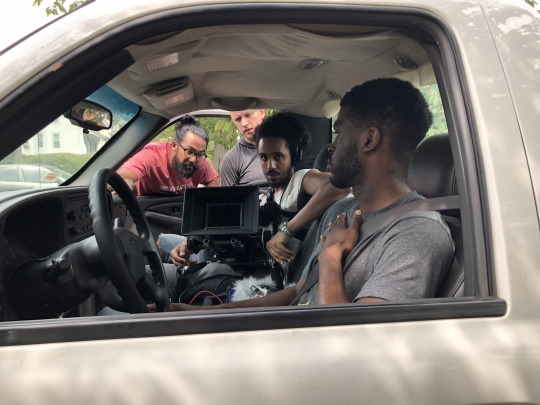
Mark Jeevaratnam, Merawi Gerima (with camera), and Obinna Nwachukwu on the set of ‘Residue’.
At Slamdance this past January, Residue won the audience award, and an acting prize for its star, Obinna Nwachukwu, whose story is a lesson for other aspiring actors. He was right for the role (“He fit the bill in terms of, he knows DC lingo, he knows the culture, he’s from the area, which was incredibly important”). More importantly, he was available. “The fact that we didn’t have resources, we needed somebody like him. He wants to act. He designs his life in his way where he was able to give us two weeks without knowing much about us. Once we got him, everything else became a lot easier.”
After Slamdance, of course, 2020 took a bit of a turn. Residue was shortlisted for Cannes, but that was cancelled and in May Gerima told his college paper: “I think that the festival prospects for the rest of this year are getting dimmer by the day.” When we speak, however, he is in Venice, where his debut feature has just screened in the independent Venice Days section of La Biennale di Venezia. It turns out that Cannes Directors’ Fortnight head Paolo Moretti had put in a word with Venice Days. As 2020 goes, this is as good as it gets for new filmmakers—and is a beautiful demonstration of how the global festival community has pulled together to make something good out of the mess we’re in.
Likewise, Gerima is grateful to Ava DuVernay’s ARRAY Releasing, who made the Netflix deal. He notes that a Black-led distribution company is a luxury his parents never knew. “I think if Ava did not exist, our film probably would not have distribution. The broad imagination necessary to see the commercial potential of Black films is still not there. I’m often sad thinking about the fact that my parents had no such opportunity.” Like a scene straight out of Dolemite is My Name, Gerima describes how his folks would book their own theaters across the US and use the African diaspora to help fill them, “proving the commercial nature of these films, in communities that hungered for real Black stories”.
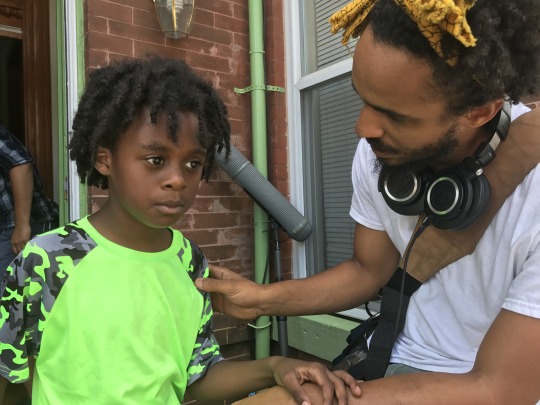
Merawi Gerima directs Jacari Dye on the set of ‘Residue’.
Gerima’s film appetite is wide, and he’s often looked outside the US for inspiration. Some of the most crucial films in his development as a director have been the 1968 post-revolutionary Cuban films Lucia and Memories of Underdevelopment. He is also a fan of La Lengua de las Mariposas (‘Butterfly’, 1999, José Luis Cuerda), which has “one of my favorite endings in film, period”. Japanese influences include Akiro Kurosawa’s Seven Samurai (1954) and Kaneto Shindo’s The Naked Island (1960) and he also looks to Chilean legend Miguel Littin and Soviet directors Andrei Tarkovsky, Sergei Eisenstein and Nikita Mikhalkov. His go-to comfort film? “Akira. I don’t know if it’s comfort, but I watch it all the time! I just think it’s one of the best films ever made.”
On the home front, an “incredible, important” American film is Ivan Dixon’s 1973 action drama The Spook Who Sat by the Door, while the movies that “really put me onto talking to girls” are Gina Prince-Bythewood’s Love & Basketball and Rick Famuyiwa’s The Wood. “These are the types of films, circulating within the Black community [that] we memorize the lines to. That set the sexual compass of Black adolescents, you know what I mean?”

‘Sankofa’ (1993), written and directed by Haile Gerima.
His parents, however, remain Gerima’s greatest influence. “Sankofa was made without arbitration. Black stories that have no minders like that, nobody to answer to, often are far and away, the most honest types of Black storytelling that we see in film.” For other storytellers yet to take the first step, he offers this: “My best lesson from this film has been to always and at all times green-light my own self, my own actions, because that’s the only thing that I can control—and to not wait for conditions to be right or perfect.”
Acknowledging the privilege of being born into a filmmaking family, Gerima adds: “That may not apply to everybody. There are many, incredible things which prohibit action at times. But I think that there are many incredible conditions under which people can take action with the camera. I think that it’s really just a matter of how urgently that story burns within you. I can only say for myself, that’s the way the film got made. Without that, it would have been literally impossible.”
When asked who we should watch next, Gerima recommends 200 Meters, written and directed by Palestinian filmmaker Ameen Nayfeh. (“He’s an incredibly poised and principled filmmaker.”) The film won the audience award at Venice Days. He also recommends Really Love by Angel Kristi Williams, which won a SXSW Special Jury Recognition for acting, and will feature as a Special Presentation at AFI Fest next month.
‘Residue’ is in select US theaters and on Netflix now. Follow Gemma on Letterboxd.
#merawi gerima#haile gerima#la rebellion#residue#netflix#netflix film#array#array releasing#ava duvernay#washington dc#washington dc films#usc#usc cinema arts#letterboxd
7 notes
·
View notes
Photo

Best of the Fests 2020.
From 17th-century werewolves to WWII gremlins to present-day nomads, the stripped-back, mostly virtual 2020 fall festivals still managed to bring the goods. Our team rounds up the very best titles we saw at TIFF, NYFF, the BFI London Film Festival and beyond.
LISTEN: Gemma Gracewood and Ella Kemp chew over their festival favorites in the latest episode of The Letterboxd Show.
Kudos to the teams at the Toronto, New York and BFI London Film Festivals for pulling excellent hybrid festivals together in extremely weird, not-at-all-ideal circumstances. From the always-excellent conversations (and Cameron Bailey’s always-excellent suits) to the hybrid options for viewing, we left feeling hope for our favorite art form.
We have been keeping track, over on our Twitter account, of the many film festivals going online, and it’s safe to say that virtual film festivals—and the wider accessibility they offer—have been a silver lining to this mostly awful year. Indeed, the 58th NYFF was one of Film at Lincoln Center’s most-attended festivals, with 70,000+ attendees in all 50 states and beyond. (We participated in a NYFF Industry Talk, along with MUBI and Rotten Tomatoes, about the future of online film conversation, moderated by Indiewire’s David Ehrlich.)
Attempting to replicate the extreme fatigue of the real thing, our festival team (Ella Kemp, Aaron Yap, Kambole Campbell, Jack Moulton and Gemma Gracewood and—helping us bridge the geo-locked divide—Canadian TIFF regular Jonathan White) disregarded international date lines and dove right in. We saw many films to love, but by consensus (and a poke around your Letterboxd reactions) these are the ones we’re still thinking about.
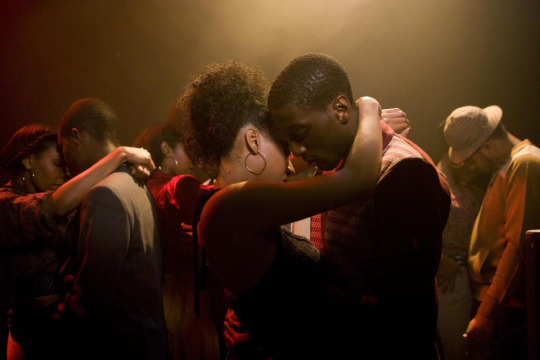
Lovers Rock
Directed by Steve McQueen, written by McQueen and Courttia Newland. The ‘Small Axe’ anthology will be released on a weekly rollout on Amazon Prime Video beginning November 20 with ‘Mangrove’, then ‘Lovers Rock’, ‘Red, White and Blue’, ‘Alex Wheatle’ and finally ‘Education’. Seen at: NYFF, BFI London Film Festival.
Lovers Rock, the first part of Steve McQueen’s ambitious, multi-part film project Small Axe, feels like a massive stylistic departure for the filmmaker, in a manner that completely transfixes and astounds. It’s no wonder that this one turned heads at multiple festivals, as it’s immediately warmer, more freewheeling and sensual than any other McQueen work. It’s defined by a hypnotic focus on sound and touch, represented in its earliest scenes with a tactile close-up of a heated comb working its way through hair, and later with its focus on hands wrapped around shoulders, moving across shirts and dresses, people joining together and/or colliding through song and dance. Despite being made for television, it’s astounding how little Lover’s Rock feels that way. Often impressionistic and unbound to the kind of urgency or efficiency that naturally comes with having to adhere to a time-slot, it simply rests in the moment. With the seismic protests being undertaken by Black people this year, Lovers Rock feels like more than welcome respite from a hateful populace—visually rich, gorgeously soundtracked Black joy and love. Also, man, those shirts are incredible. —KC
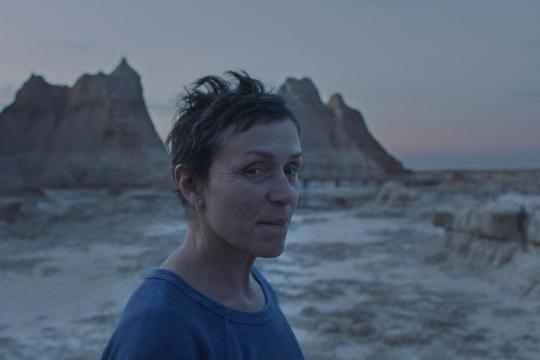
Nomadland
Written and directed by Chloé Zhao. In US theaters December 4. Seen at: TIFF, NYFF, BFI London Film Festival.
“I am already convinced that Chloé Zhao deserves the whole world,” writes Jaime of Nomadland, the TIFF People’s Choice winner. Personal security is something we don’t think about on a daily basis. We have shelter, we can buy food, anything else is bonus. But what if those two basic tenets vanish? While the global financial crisis affected all in 2008, it affected retirees more. Supposedly secure retirement investments vanished; security no more. What do you do? Survive. Zhao’s adaptation of Jessica Bruder’s 2017 non-fiction masterpiece Nomadland: Surviving America in the Twenty-First Century is a beacon of human spirit and survival. It may not be pretty, but it’s real. It’s not something to be embarrassed about, it’s something to be proud of. Those that let this happen to good, honest working people should be the ones embarrassed. —JW

Minari
Written and directed by Lee Isaac Chung. No release date announced. Seen at: Middleburg Film Festival.
Minari is the medicine for these tough times. It’s a wonderful, wonderful, deeply personal, utterly serene and metaphysical portrait of America—freedom, faith, superstition, forces of nature, and ambition collide with the costs of intoxicating capitalist dreams, but not without a whole lot of heart. This is elegantly crafted, at once organic in its approach and always sweepingly cinematic. The film’s gentle sense of humor ensures that it never takes itself too seriously and allows the weight of its poetic images and juxtapositions to guide the narrative. The brilliant ensemble should grow to join Steven Yeun as household names (well, cinephile households). Youn Yuh-jung and Alan Kim are bright sparks as the latest classic duo of sassy grandma and precocious grandchild, but it’s Han Ye-ri—taking on the surrogate role of director Lee Isaac Chung’s mother—who provides an overlooked and tender sounding board for familial bonds in fraction. Minari is truly one of 2020’s most invaluable and essential pieces of art, living up to the hype built since Sundance. Korea came to the USA for the Oscars earlier this year, and if 2021 shows similar mercy, there’s a chance you’ll see this home-grown Asian-American picture mounting that stage in future. —JM

Wolfwalkers
Directed by Tomm Moore and Ross Stewart, written by Will Collins with Moore and Stewart. Recently released in UK theaters; coming to Apple TV+ December 11. Seen at: TIFF, BFI London Film Festival.
The much-anticipated Cartoon Saloon adventure Wolfwalkers was met with only joy around here. A fable about what happens when a colonizing force tries to tame a wild forest, set during Oliver Cromwell’s Siege of Kilkenny, Wolfwalkers builds to “one of the most sensational animated third acts I’ve seen in years,” according to Animatedantic. The film’s themes are embedded in every hand-drawn line and stroke. “It’s not sleek and seamless and modern,” writes Cow Shea. “This is transparently a true work of art where all the work of that art is part of the finished product.” Mebh and Robyn are animated action heroes for the ages, and you’ll hear a lot about ‘Wolfvision’ in the weeks to come—for very good reason. Werewolf films have, for years, tried different ways to put us inside the beast’s mind, but Tomm Moore and Ross Stewart followed their noses and it’s as thrilling as things get. —GG
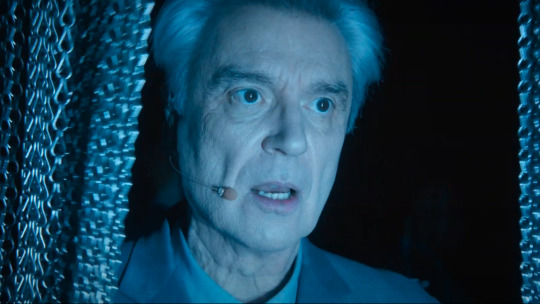
David Byrne’s American Utopia
Directed by Spike Lee. On HBO and HBO Max now. Seen at: TIFF, NYFF, BFI London Film Festival.
David Byrne’s American Utopia is well on track to join Jonathan Demme’s film of another Byrne stage outing, Stop Making Sense (1984), as one of the highest-rated anythings on Letterboxd. We’re still deciding whether this film is sublime because the stage show itself is sublime, or because Spike Lee has sublimely captured the whole joyous thing for us to inject into our eyeballs, time and again, for far less than the price of a Broadway ticket. Let’s be honest: it’s due to both, and more besides. It’s a blessing upon 2020, of that we are certain. As Clint writes, “The phrase ‘this is the film we need right now’ is such a creaky cliché, but there’s an ineffable feeling that, if David Byrne and Spike Lee can’t heal the world with grey suits, bare feet, and some of the most all-encompassing works of music ever written, no one can.” As my colleague says, “will rewatch to death”. —GG
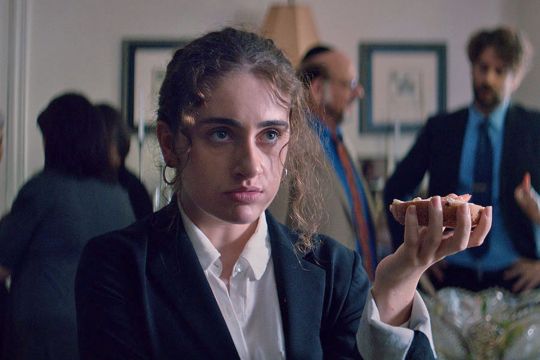
Shiva Baby
Written and directed by Emma Seligman. On the festival circuit. Seen at: TIFF, LFF.
A girl walks into a shiva and bumps into her sugar daddy. What sounds like a joke sets up 77 minutes of note-perfect comedy horror in Emma Seligman’s Shiva Baby, her feature debut adapted from her dissertation short of the same name. It’s funny, horrifying, excruciating and so painfully, accurately Jewish. Isaac Feldberg calls it “cruelly hilarious about everything smothering and inevitably miserable about Jewish family gatherings”, but Seligman’s sharp eye for comedy, her affection for her teen hero Danielle (Rachel Sennott, a bona fide star) just figuring her career out and owning her sexuality (Molly Gordon playing Danielle’s overachieving ex-girlfriend Maya is a highlight) cuts straight to the core, however you relate. Matt Neglia points out how Shiva Baby “captures the behaviors of its characters with the same level of dry wit and detail as the Coen Brothers would”. What a thrill for a young, smart, Jewish, bisexual woman to be setting the pace now. Keep an eye on Seligman’s bright, bright future. —EK
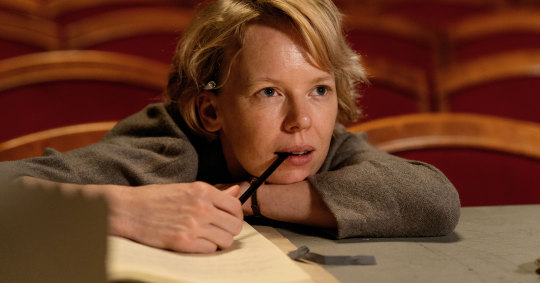
Tove
Directed by Zaida Bergroth, written by Eeva Putro. Released in Finland; on the festival circuit elsewhere. Seen at: TIFF.
If there was a film swoony enough to fill the Portrait of a Lady on Fire-sized hole in your heart this year, it’s Zaida Bergroth’s Tove, a bewitching biopic of Finnish author and illustrator Tove Jansson, creator of the beloved Moomin cartoon characters. Set in Helsinki during and post-World War II, the film orbits around her boho world, flitting between her creative struggles as a painter and deep sexual awakening with married theater director Vivica Bandler (Krista Kosonen). As Lillian says, “Lesbians and Moomins is such a huge fucking mood I never wanted it to end.” Alma Pöysti shines effortlessly in the lead role. “The film happens on her fantastic face,” writes Hannu. Seth agrees: “a captivating first-class drama about a world-renowned talent in search of her own identity, love and freedom.” A cozy fall-season perfection. —AY

Shadow in the Cloud
Co-written and directed by Roseanne Liang. Slated for a summer 2021 release. Seen at: TIFF, AFI Fest.
A proud addition to the “she did that!” canon, the single downside of Roseanne Liang’s genre-perfect, “deliciously fearless” Midnight Madness winner Shadow in the Cloud is that there was no Midnight Madness to experience it at—but thanks to a juicy sale out of TIFF, we can look forward to a premiere next summer. Chloë Grace Moretz is Maude Garrett, a WWII pilot assigned to transport a highly classified package over the Pacific. The all-male crew of the B-17 Flying Fortress banishes her to the lower ball turret, where they harass, gaslight and leer over her—and that is nowhere near the worst part of this bonkers, non-stop hell flight, which Moretz carries like the future action hero she must now become, if the movie goddesses are listening. —GG
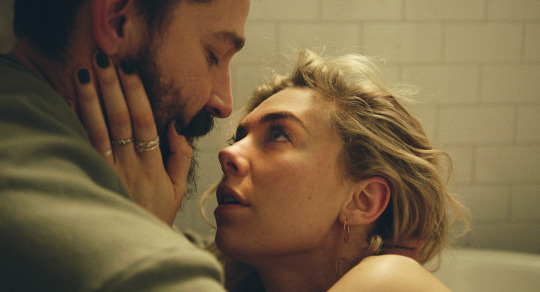
Pieces of a Woman
Directed by Kornél Mundruczó, written by Kata Wéber. Coming soon to Netflix. Seen at: TIFF, NYFF.
You will be hearing a lot about Vanessa Kirby in the months to come. Pieces of a Woman is an arresting, often taxing watch, but few actors have delivered a performance as utterly overwhelming as Kirby portraying Martha, a grieving mother processing the loss of her baby. The filmmaking team (Mundruczo and Weber share a “film by” credit) zoom in on deep, jagged pain, and tease out some of the most affecting moments put to screen this year. Jack calls the film “an intensely intimate depiction of mental and marital deterioration caused by tragedy” and nods to master Howard Shore’s “subtle yet potent” score. It’s poetry in motion, with stunning turns from Shia LaBeouf, Ellen Burstyn, Sarah Snook and Benny Safdie also. But proceed with caution: “this film will destroy you”, Alisha Tabilin warns. —EK

Underplayed
Directed by Stacey Lee. On the festival circuit. Seen at: TIFF. (Also recommended in our music movies round-up.)
Women-in-the-workplace movies aren’t usually this banging. Stacey Lee’s documentary Underplayed focuses on one corner of the still wildly sexist music industry—the dance-music scene—and lays out both the facts and feelings regarding why women still, always, deserve better. A number of key names guide the story—Rezz, Alison Wonderland, Nervo, TokiMonsta—giving the viewer a taste of what we’re missing out on while booking the same old men, over and over. And it’s not just because of the stats or the injustices that this is a must-watch: in times of limited social interaction and when the feeling of an adrenaline-fuelled crowd feels like a foggy memory, Lee captures some truly electric moments of these women thriving, captivating thousands of music lovers at once. “Buy yourself good speakers and turn them up because this movie is fun and it deserves it,” writes Matt Brown, and he’s absolutely correct. Underplayed is essential and exciting. The most entertaining education of the year. —EK

Another Round
Directed by Thomas Vinterburg, written by Vinterburg and Tobias Lindholm. Awaiting new UK date due to lockdown. In US cinemas soon. Seen at: TIFF, LFF.
Another Round reunites filmmaker Thomas Vinterberg with his muse Mads Mikkelsen, in a lads-on-tour buddy movie, except the lads are four middle-aged high-school teachers, and the tour features a very casual, very constant level of intoxication each man commits to in the name of a social experiment. What could possibly go wrong, you ask? Plenty, naturally—but Vinterberg marries the slapstick moments of bumbling drunks falling over themselves with more mature, poignant scenes that question just how far you can or should go to feel that little bit more alive. There’s a lot to love here, but if we’re being very precise, it’s “rock-solid proof that Mads Mikkelsen is one of our greatest actors,” says Karen Han. Come for the wise, contemplative study of youth and spontaneity, stay for rock-solid proof that Mads Mikkelsen is also, somehow, one of our greatest contemporary dancers. —EK
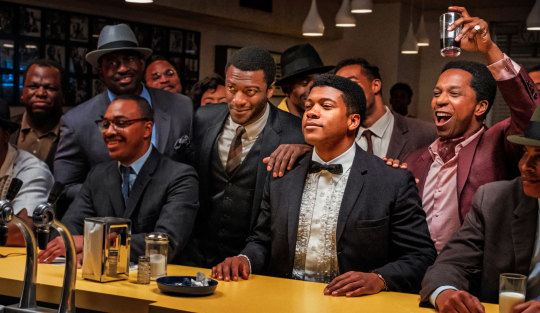
One Night in Miami
Directed by Regina King, adapted by Kemp Powers from his own stage play. In select US theaters December 25, coming to Amazon Prime Video January 15, 2021. Seen at: TIFF, NYFF.
Ladies and gentleman, Regina King has arrived. The actor wastes nothing in her feature directorial debut, bringing to the screen Kemp Powers’ vivid stage play of the same name with a heavyweight cast of greats. Kingsley Ben-Adir, Eli Goree, Aldis Hodge and Leslie Odom Jr. are Malcolm X, Cassius Clay (before he took the name Muhammad Ali), Jim Brown and Sam Cooke respectively, as the four men celebrate Clay’s victory over Sonny Liston in February 1964, during One Night in Miami. Rachel Wagner notes how “they all feel like friends and have chemistry, but each with a unique perspective”. This chemistry comes from King’s perfect alchemy of mood, design and structure; she lets her men speak, but her voice is never lost. “Queen King never wavers on her vision until every bit of flesh is torn off each man,” Ben notes, admiring a film that shines for all its famous faces, but stands the test of time for its rich, piercing empathy for every other one waiting in the shadows. —EK
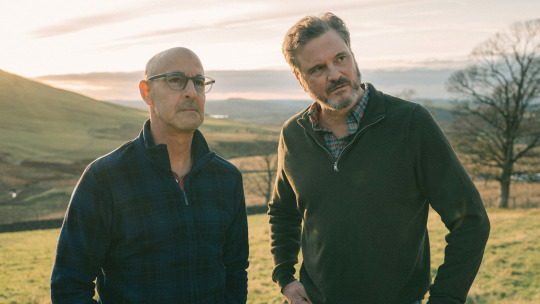
Supernova
Written and directed by Harry Macqueen. Awaiting UK and Ireland release due to lockdown; in select US theaters January 29, 2021. Seen at: BFI London Film Festival.
Colin Firth at his very best, Stanley Tucci losing his grip on himself, the luscious Lake District and endless cozy, delicious, warm knitwear. Supernova is every bit as beautiful as it sounds, but also packs a major punch when it comes to mapping a lifelong love story, and the cost of loyalty and pride when you’re fighting against pain nobody can control. As Sam and Tusker, devoted to one another for decades, come to terms with Tusker’s diagnosis of early on-set dementia, there is as much care and sadness as is to be expected, but it still feels brand new and cuts deep. Every good love story is its own. Director Harry Macqueen and his two shining stars understand this better than anyone. —EK

French Exit
Directed by Azazel Jacobs, written by Patrick DeWitt. Scheduled for US release January 21, 2021. Seen at NYFF.
Armed with acerbic wit and sharpened claws, Michelle Pfeiffer delivers a vulnerable close-to-career-best performance in French Exit as a mother free-falling from wealth and reconciling with her son, an expertly cold Lucas Hedges. What appears to be formal and dry (“rich white-people stuff”, blegh) is actually wonderfully weird and surprisingly spiritual. There’s a divisive scene at the half-way point that instantly unroots the movie from any grounding we assumed it had established. In any other film, it would open up an entire world of possibilities, but French Exit decidedly treats it as matter-of-fact in order to focus on the emotional journey. It’s the decisive moment—you’re on its wavelength, or you’re overboard—and the rewards for staying aboard are plentiful. Patrick DeWitt’s adaptation of his own novel is in good hands with director Azazel Jacobs. —JM
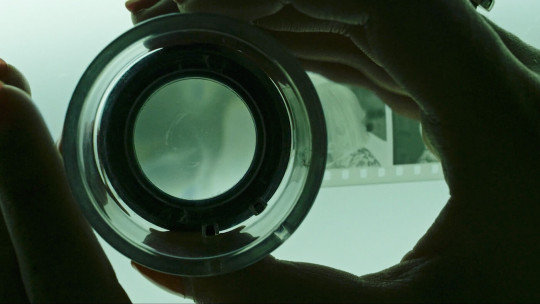
Still Processing
Directed by Sophy Romvari. On the festival circuit. Seen at: TIFF.
A final, honorable mention for Sophy Romvari’s Still Processing, the highest-rated short film out of TIFF, and an excavation of grief like no other. “You’ve got to watch this one twice,” writes Martyn. “First viewing to just weep every two to three minutes. Second viewing to really appreciate how great it is.”
#tiff#tiff20#tiff2020#toronto international film festival#nomadland#chloe zhao#wolfwalkers#cartoon saloon#bfi#bfi london film festival#nyff#nyff2020#filmlinc#film at lincoln center#New York Film Festival#film festival#best of 2020#2020 best#best films of 2020#letterboxd
4 notes
·
View notes
Photo

Bong Hit!
Today Parasite overtook The Godfather as the highest-rated narrative feature film on Letterboxd. We examine what this means, and bring you the story of the birth of the #BongHive.
It’s Bong Joon-ho’s world and we’re just basement-dwelling in it. While there is still (at time of publication) just one one-thousandth of a point separating them, Bong’s Palme d’Or-winning Parasite has overtaken Francis Ford Coppola’s Oscar-winning The Godfather to become our highest-rated narrative feature.
In May, we pegged Parasite at number one in our round-up of the top ten Cannes premieres. By September, when we met up with Director Bong on the TIFF red carpet, Parasite was not only the highest-rated film of 2019, but of the decade. (“I’m very happy with that!” he told us.)
Look, art isn’t a competition—and this may be short-lived—but it’s as good a time as any to take stock of why Bong’s wild tale of the Kim and Park families is hitting so hard with film lovers worldwide. To do so, we’ve waded through your Parasite reviews (warning: mild spoilers below; further spoilers if you click the review links). And further below, member Ella Kemp recalls the very beginnings of the #BongHive.

Bong Joon-ho on set with actors Choi Woo-shik and Cho Yeo-jeong.
The Letterboxd community on Parasite
On the filmmaking technique:
“Parasite is structured like a hill: the first act is an incredible trek upward toward the light, toward riches, toward reclaiming a sense of humanity as defined by financial stability and self-reliance. There is joy, there is quirk, there is enough air to breathe to allow for laughter and mischief.
“But every hill must go down, and Parasite is an incredibly balanced, plotted, and paced descent downward into darkness. The horror doesn’t rely on shock value, but rather is built upon a slow-burning dread that is rooted in the tainted soil of class, society, and duty… Bong Joon-ho dresses this disease up in beautiful sets and empathetic framing (the camera doesn’t gawk, but perceives invisible connections and overt inequalities)—only to unravel it with deft hands.” —Tay
“Bong’s use of landscape, architecture, and space is simply arresting.” —Taylor Baker
“There is a clear and forceful guiding purpose behind the camera, and it shows. The dialogue is incredibly smart and the entire ensemble is brilliant, but the most beautiful work is perhaps done through visual language. Every single frame tells you exactly what you need to know while pulling you in to look for more—the stunning production design behind the sleek, clinical nature of one home and the cramped, gritty nature of the other sets up a playpen of contrasts for the actors and the script.” —Kevin Yang
On how to classify Parasite:
“Masterfully constructed and thoroughly compelling genre piece (effortlessly transitioning between familial drama, heist movie, satirical farce, subterranean horror) about the perverse and mutating symbiotic relationship of increasingly unequal, transactional class relationships, and who can and can’t afford to be oblivious about the severe, violent material/psychic toll of capitalist accumulation.” —Josh Lewis
“This is an excellent argument for the inherent weakness of genre categories. Seriously, what genre is this movie? It’s all of them and none of them. It’s just Parasite.” —Nick Wibert
“The director refers to his furious and fiendishly well-crafted new film as a ‘family tragicomedy’, but the best thing about Parasite is that it gives us permission to stop trying to sort his movies into any sort of pre-existing taxonomy—with Parasite, Bong finally becomes a genre unto himself.” —David Ehrlich
On the duality of the plot:
“There are houses on hills, and houses underground. There is plenty of sun, but it isn't for everybody. There are people grateful to be slaves, and people unhappy to be served. There are systems that we are born into, and they create these lines that cannot be crossed. And we all dream of something better, but we’ve been living with these lines for so long that we've convinced ourselves that there really isn’t anything to be done.” —Philbert Dy
“The Parks are bafflingly naive and blissfully ignorant of the fact that their success and wealth is built off the backs of the invisible working class. This obliviousness and bewilderment to social and class inequities somehow make the Parks even more despicable than if they were to be pompous and arrogant about their privilege.
“This is not to say the Kims are made to be saints by virtue of the Parks’ ignorance. The Kims are relentless and conniving as they assimilate into the Park family, leeching off their wealth and privilege. But even as the Kims become increasingly convincing in their respective roles, the film questions whether they can truly fit within this higher class.” —Ethan
On how the film leaps geographical barriers:
“As a satire on social climbing and the aloofness of the upper class, it’s dead-on and has parallels to the American Dream that American viewers are unlikely to miss; as a dark comedy, it’s often laugh-aloud hilarious in its audacity; as a thriller, it has brilliantly executed moments of tension and surprises that genuinely caught me off guard; and as a drama about family dynamics, it has tender moments that stand out all the more because of how they’re juxtaposed with so much cynicism elsewhere in the film. Handling so many different tones is an immensely difficult balancing act, yet Bong handles all of it so skilfully that he makes it feel effortless.” —C. Roll
“One of the best things about it, I think, is the fact that I could honestly recommend it to anyone, even though I can't even try to describe it to someone. One may think, due to the picture’s academic praise and the general public’s misconceptions about foreign cinema, that this is some slow, artsy film for snobby cinephiles, but it’s quite the contrary: it’s entertaining, engaging and accessible from start to finish.” —Pedro Machado
On the performative nature of image:
“A família pobre que se infiltra no espaço da família rica trata a encenação—a dissimulação, os novos papéis que cada um desempenha—como uma espécie de luta de classes travada no palco das aparências. Uma luta de classes que usa a potência da imagem e do drama (os personagens escrevem os seus textos e mudam a sua aparência para passar por outras pessoas) como uma forma de reapropriação da propriedade e dos valores alheios.
“A grande proposta de Parasite é reconhecer que a ideia do conhecimento, consequentemente a natureza financeira e moral desse conhecimento, não passa de uma questão de performance. No capitalismo imediatista de hoje fingir saber é mais importante do que de fato saber.” —Arthur Tuoto
(Translation: “The poor family that infiltrates the rich family space treats the performance—the concealment, the new roles each plays—as a kind of class struggle waged on the stage of appearances. A class struggle that uses the power of image and drama (characters write their stories and change their appearance to pass for other people) as a form of reappropriation of the property and values of others.
“Parasite’s great proposal is to recognize that the idea of knowledge, therefore the financial and moral nature of that knowledge, is a matter of performance. In today’s immediate capitalism, pretending to know is more important than actually knowing.”)
Things you’re noticing on re-watches:
“Min and Mr. Park are both seen as powerful figures deserving of respect, and the way they dismissively respond to an earnest question about whether they truly care for the people they’re supposed to tells us a lot about how powerful people think about not just the people below them, but everyone in their lives.” —Demi Adejuyigbe
“When I first saw the trailer and saw Song Kang-ho in a Native American headdress I was a little taken aback. But the execution of the ideas, that these rich people will siphon off of everything, whether it’s poor people or disenfranchised cultures all the way across the world just to make their son happy, without properly taking the time to understand that culture, is pretty brilliant. I noticed a lot more subtlety with that specific example this time around.” —London
“I only noticed it on the second viewing, but the film opens and closes on the same shot. Socks are drying on a rack hanging in the semi-basement by the window. The camera pans down to a hopeful Ki-Woo sitting on his bed… if the film shows anything, it might be that the ways we usually approach ‘solving’ poverty and ‘fixing’ the class struggle often just reinforce how things have been since the beginning.” —Houston

The birth of the #BongHive
London-based writer and Letterboxd member Ella Kemp attended Cannes for Culture Whisper, and was waiting in the Parasite queue with fellow writers Karen Han and Iana Murray when the hashtag #BongHive was born. Letterboxd editor Gemma Gracewood asked her to recall that day.
Take us back to the day that #BongHive sprang into life.
Ella Kemp: I’m so glad you asked. Picture the scene: we were in the queue to watch the world premiere of Bong Joon-ho’s Parasite at Cannes. It was toward the end of the festival; Once Upon a Time in Hollywood had already screened…
Can you describe for our members what those film festival queues are like?
The queues in Cannes are very precise, and very strict and categorized. When you’re attending the festival as press, there are a number of different tiers that you can be assigned—white tier, pink tier, blue tier or yellow tier—and that’s the queue you have to stay in. And depending on which tier you’re in, a certain number of tiers will get into the film before you, no matter how late they arrive. Now, yellow is the lowest tier and it is the tier I was in this year. But, you know, I didn’t get shut out of any films I tried to go into, so I don’t want to speak ill of being yellow!
So, spirits are still high in the yellow queue before going to see Parasite. I was with friends and colleagues Iana Murray [writer for GQ, i-D, Much Ado About Cinema, Little White Lies], Karen Han [New York Times, Vanity Fair, Vulture, The Atlantic] and Jake Cunningham [of the Curzon and Ghibliotheque podcasts] who were also very excited for the film. We queued quite early, because obviously if you’re at the start of a queue and only two yellow tier people get in, you want that to be you.
So we had some time to spare, and we’re all very ‘online’ people and the 45 minutes in that queue was no different. So we just started tweeting, as you do. We thought, ‘Oh we’re just gonna tweet some stuff and see if it catches on.’ It might not, but at least we could kill some time.
So we just started tweeting #BongHive. And not explaining it too much.
#BongHive
— karen han (@karenyhan)
May 21, 2019
Within the realms of stan culture, I would argue that hashtags are more applicable to actors and musicians. Ariana Grande has her army of fans and they have their own hashtag. Justin Bieber has his, One Direction, all of them. But we thought, ‘You know who needs one and doesn’t have one right now? Bong Joon-ho.’
And so, you know, we tweeted it a couple of times, but I think what mattered the most was that there was no context, there was no logic, but there was consistency and insistence. So we tweeted it two or three times, and then the film started and we thought right, let’s see if this pays off. Because it could have been disappointing and we could have not wanted to be part of, you know, any kind of hype.
SMILE PRESIDENT @karenyhan #BongHive pic.twitter.com/Dk7T8bFYtv
— Ella Kemp (@ella_kemp)
May 21, 2019
But, Parasite was Parasite. So we walked out of it and thought, ‘Oh yes, the #BongHive is alive and kicking.’
I think what was interesting was that it came at that point in the festival when enthusiasm dipped. Everyone was very tired, and we were really tired, which is why we were tweeting illogical things. It was late at night by the time we came out of that film. It was close to midnight and we should have gone to bed, probably.
Because, first world problems, it is exhausting watching five, six, seven films a day at a film festival, trying to find sustenance that’s not popcorn, and form logical thoughts around these works of art.
Yes! It was nice to have fun with something. But what happened next was [Parasite distributor] Neon clocked it and went, ‘Oh wait, there’s something we can do there’. And then they took it, and it flew into the world, and now the #BongHive is worldwide.
I love the formality of Korean language and the way that South Koreans speak of their elders with such respect. I enjoyed being on the red carpet at TIFF hearing the Korean media refer to Bong Joon-ho as ‘Director Bong’.
It’s what he deserves!
I like to imagine a world where it’s ‘Director Gerwig’, ‘Director Campion’, ‘Director Sciamma’…
Exactly.
Related content:
Ella Kemp’s review of Parasite for Culture Whisper.
Letterboxd list: The directors Bong Joon-ho would like you to watch next.
Our interview with Director Bong, in which he reveals just how many times he’s watched Alfred Hitchcock’s Psycho.
“I’m very awkward.” Bong Joon-ho’s first words following the standing ovation at Cannes for Parasite’s world premiere.
Karen Han interviews Director Bong for Polygon, with a particular interest in how he translated the film for non-Korean audiences. (Here’s Han’s original Parasite review out of Cannes; and here’s what happened when a translator asked her “Are you bong hive?” in front of the director.)
Haven’t seen Parasite yet? Here are the films recommended by Bong Joon-ho for you to watch in preparation.
With thanks to Matt Singer for the headline.
#bong joon-ho#bong hit#parasite#gisaengchung#cannes#palme d'or#the godfather#francis ford coppola#letterboxd#highest rated 2019#korean cinema#korean director#korean filmmakers#BONGHIVE#best of 2019#best of decade#highest rated film#ella kemp#david ehrlich#karen han#iana murray
147 notes
·
View notes